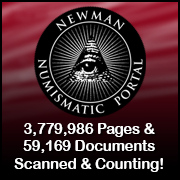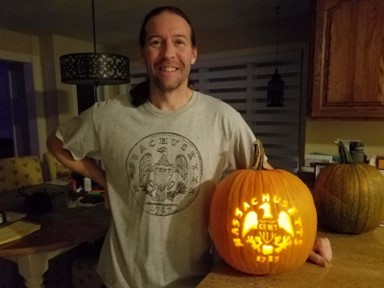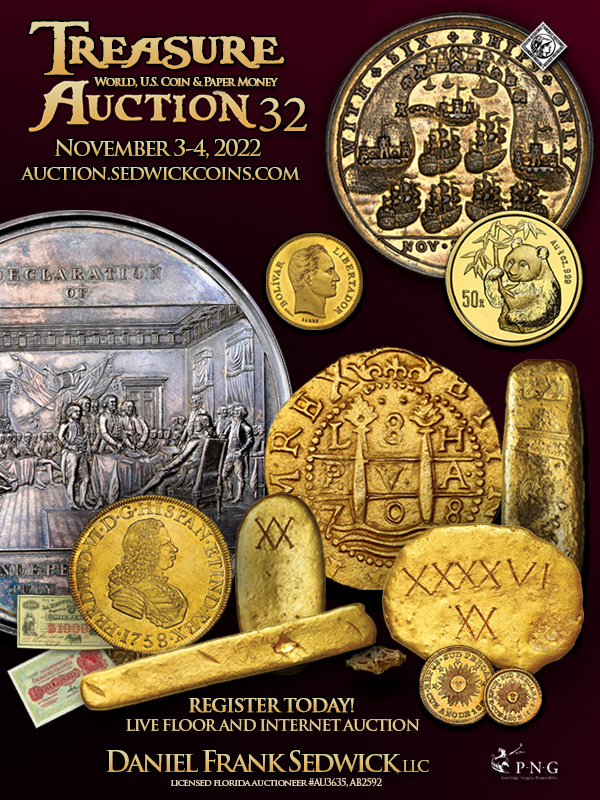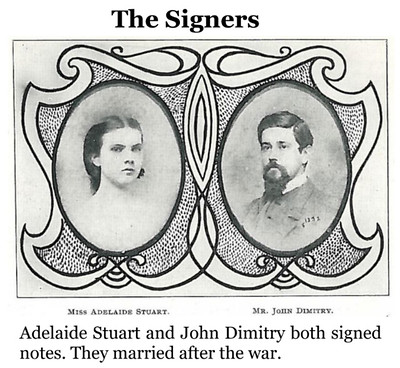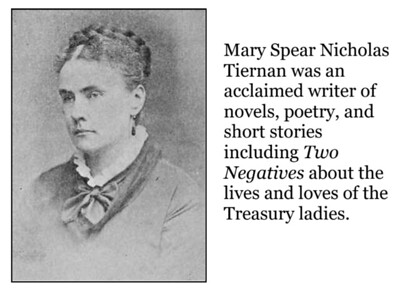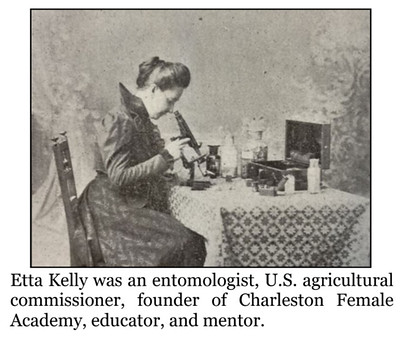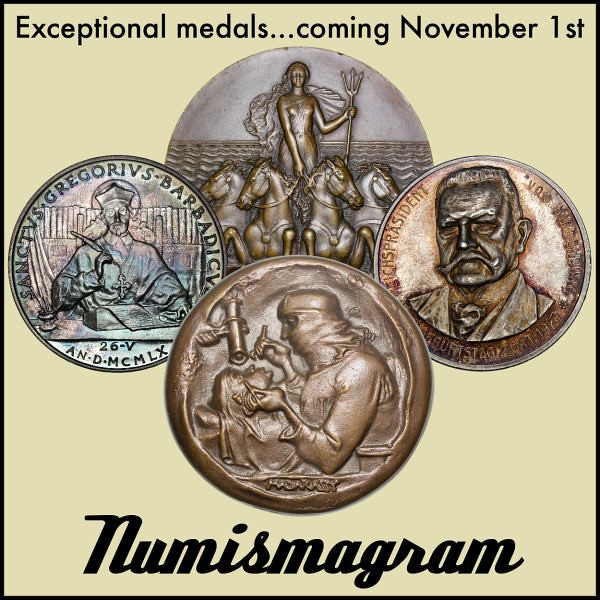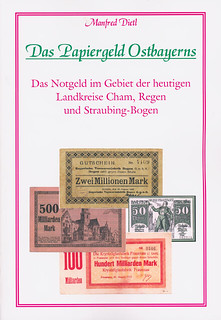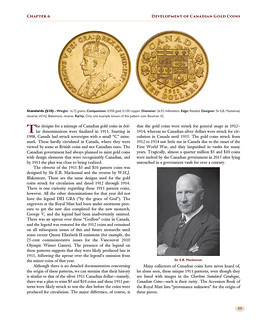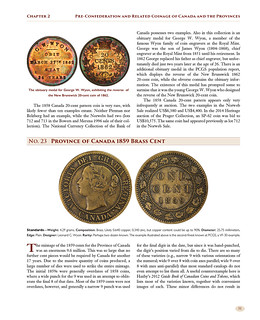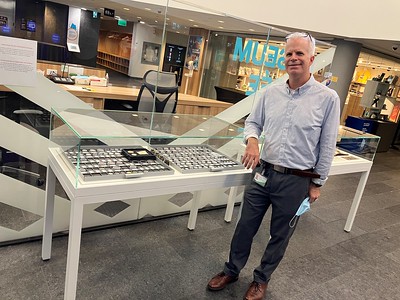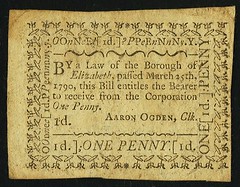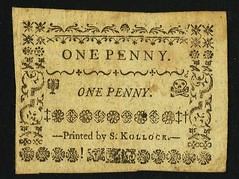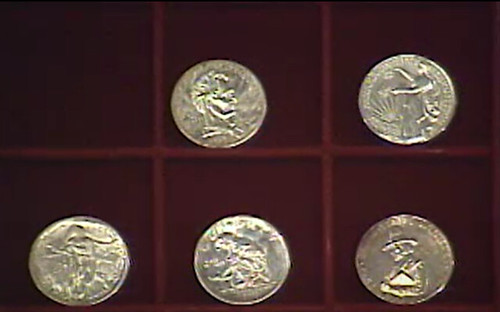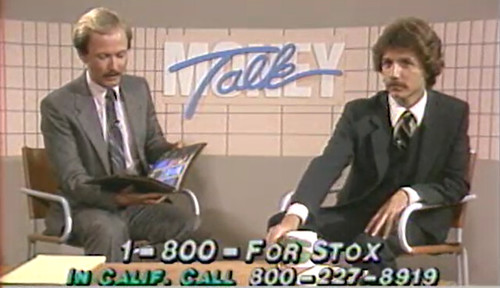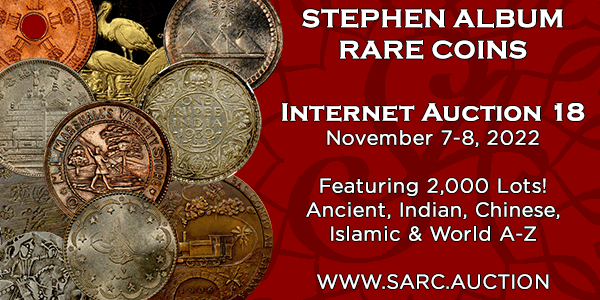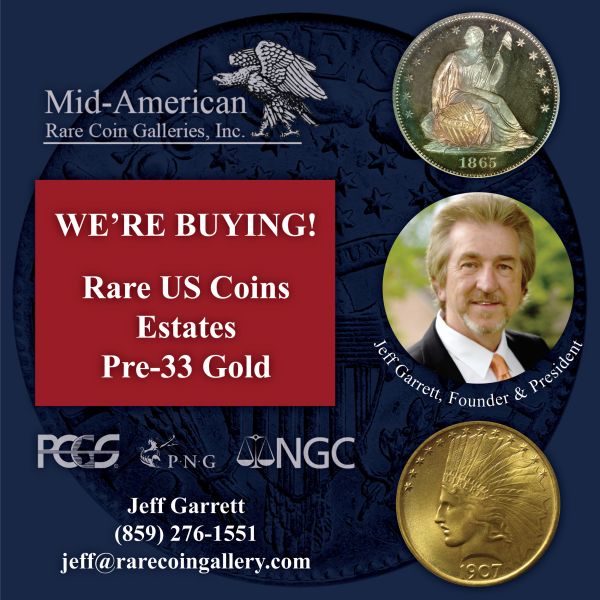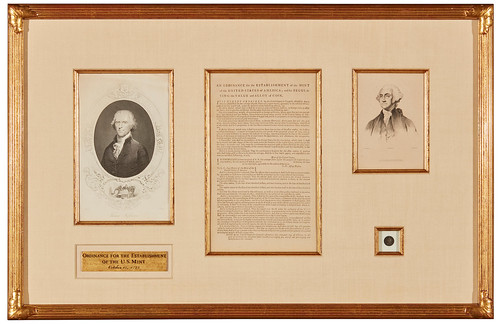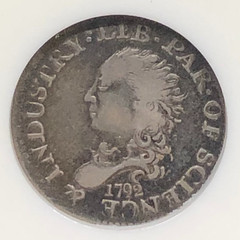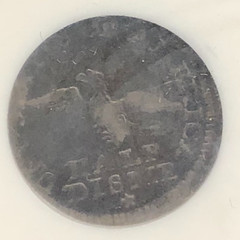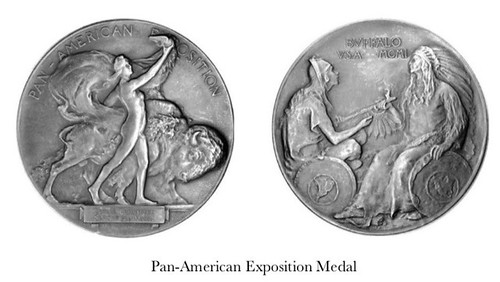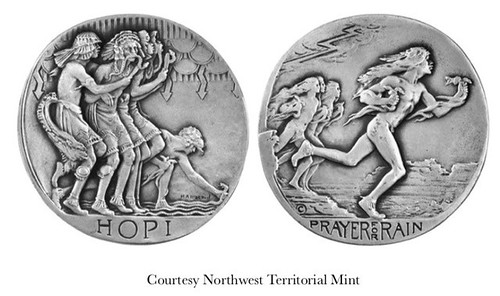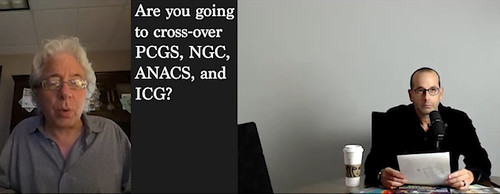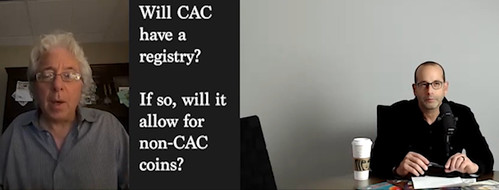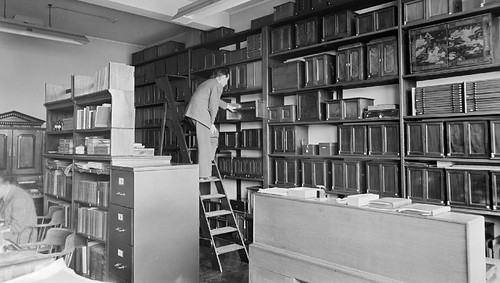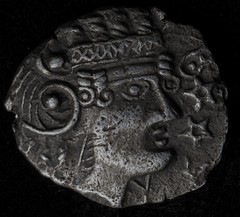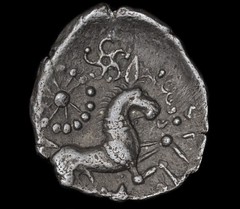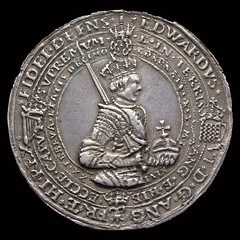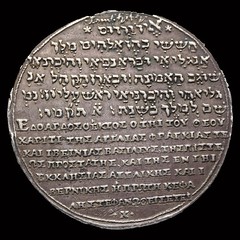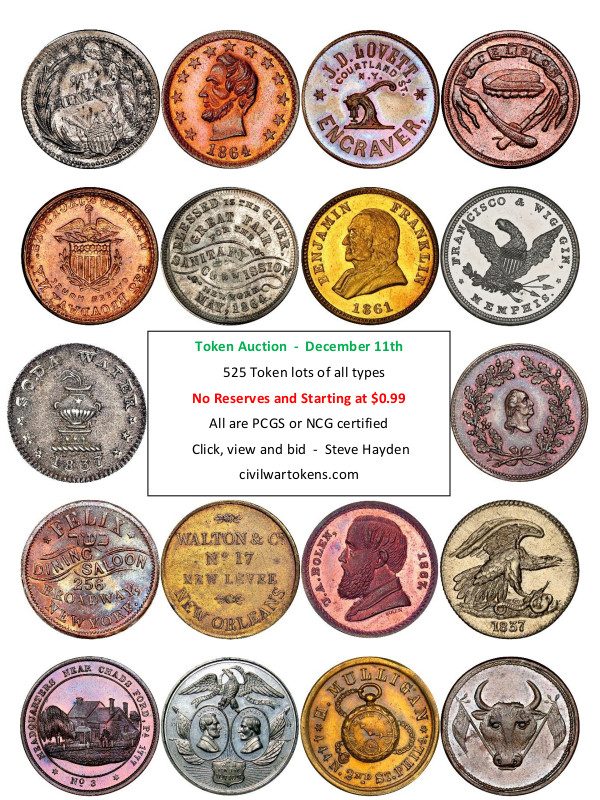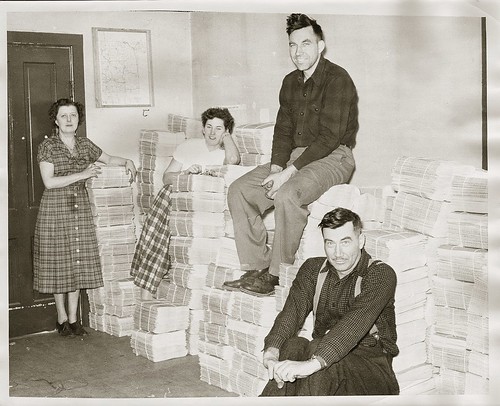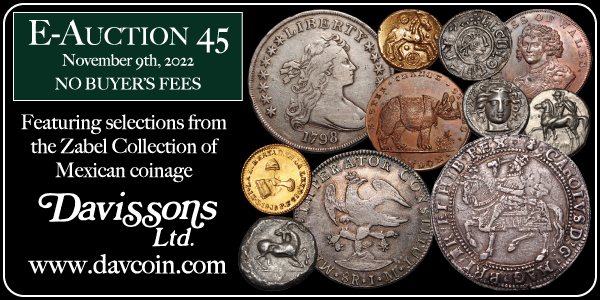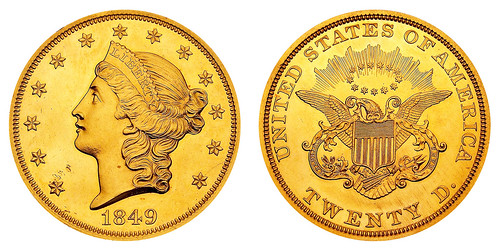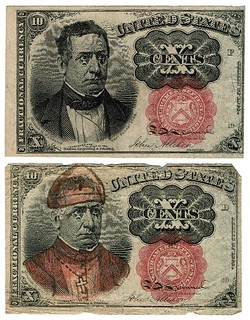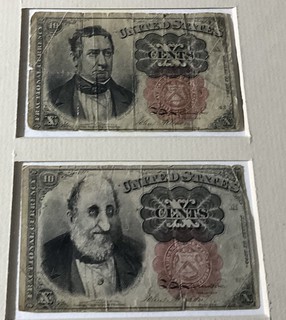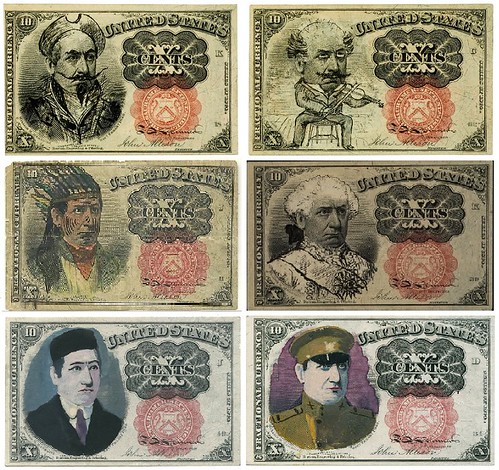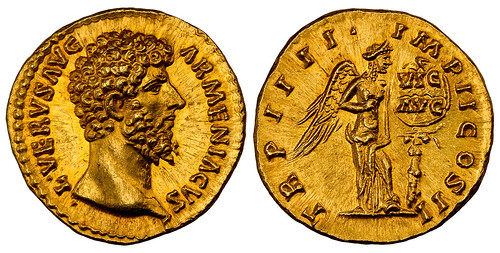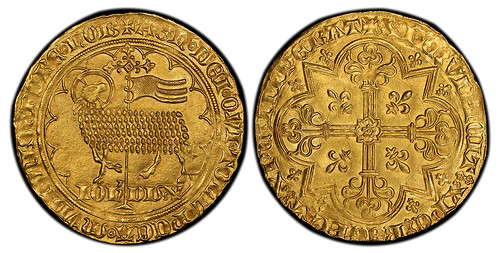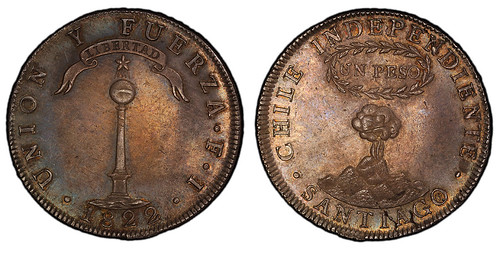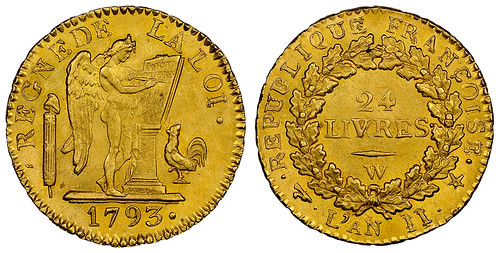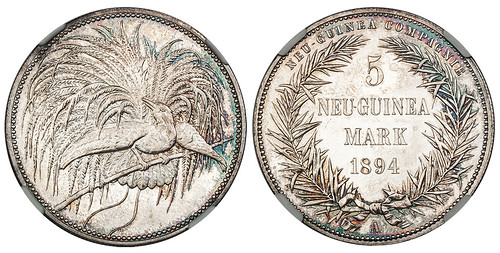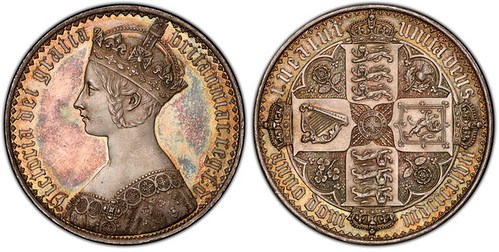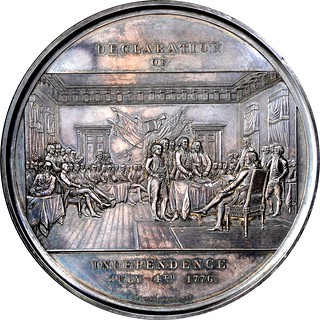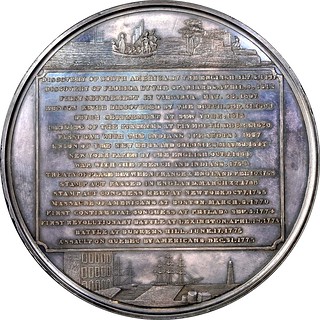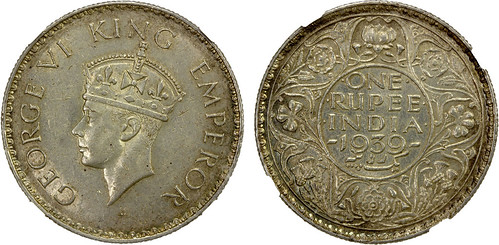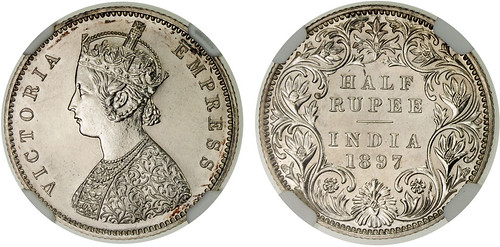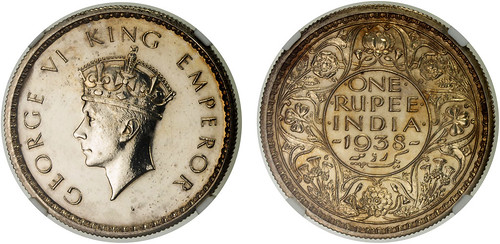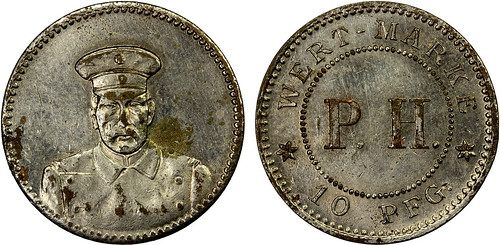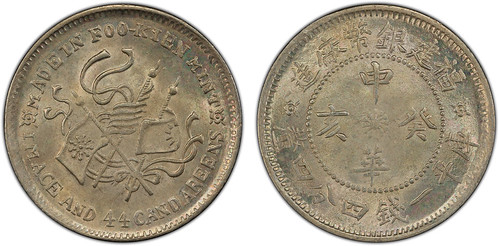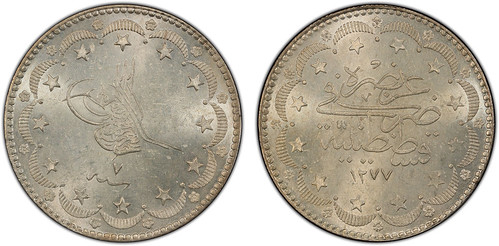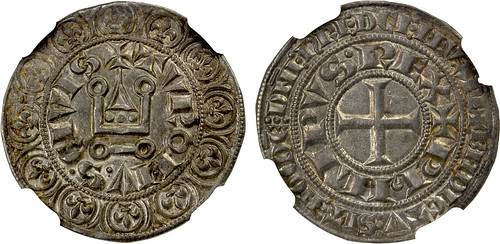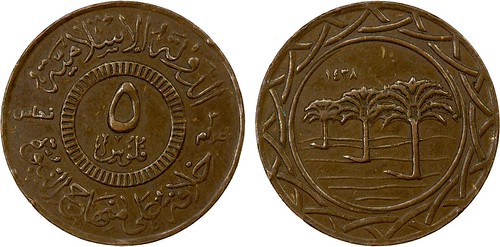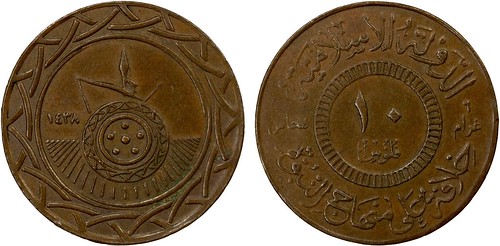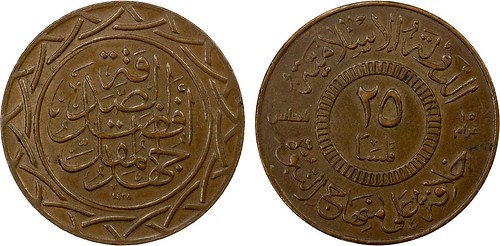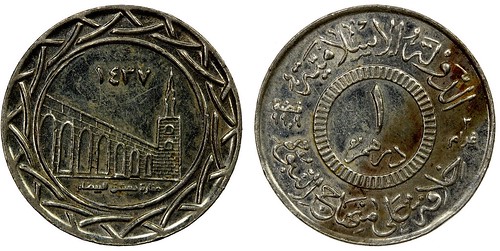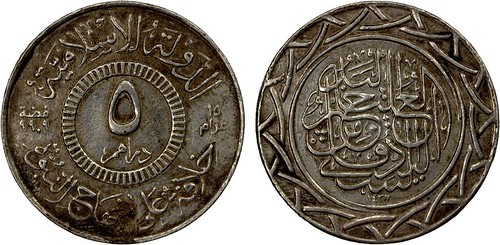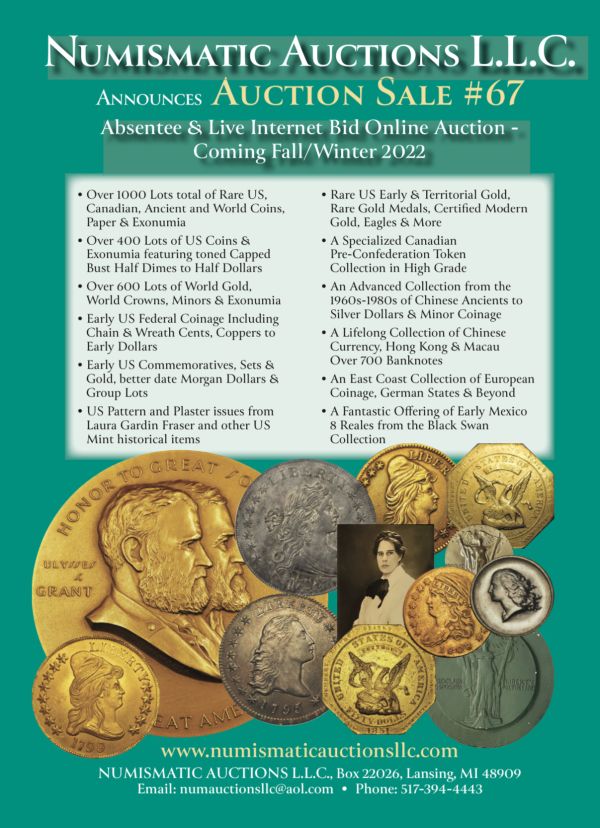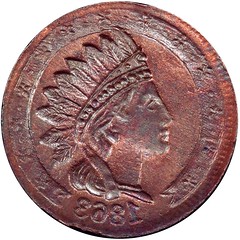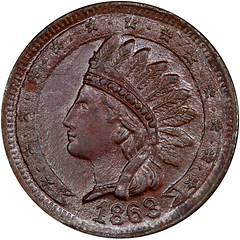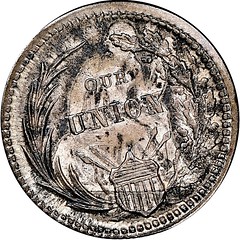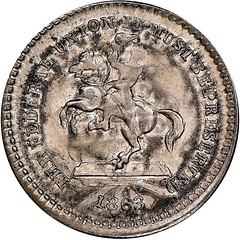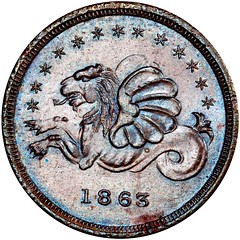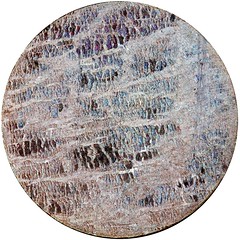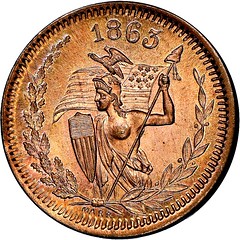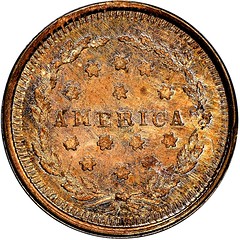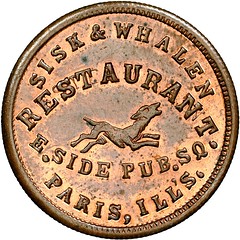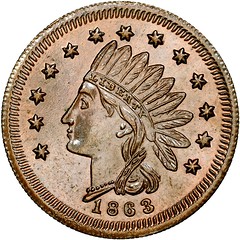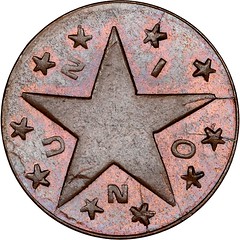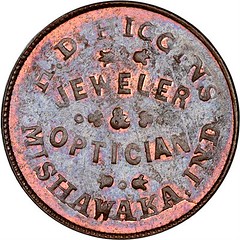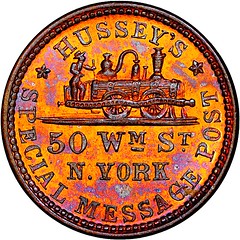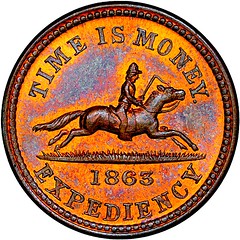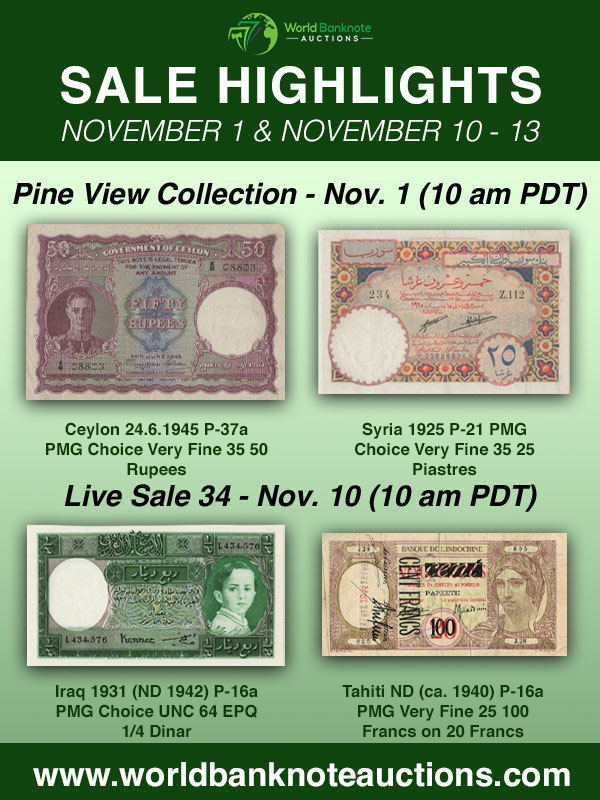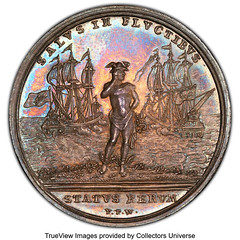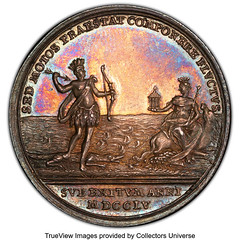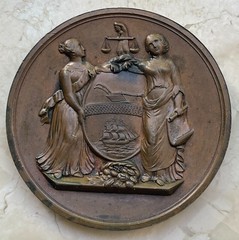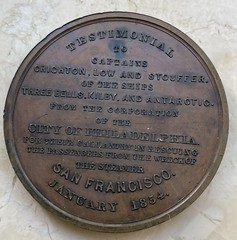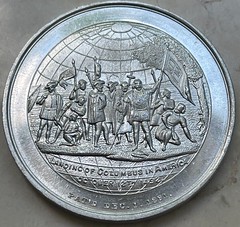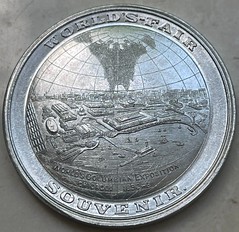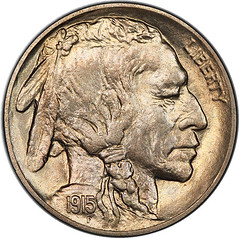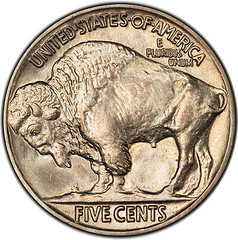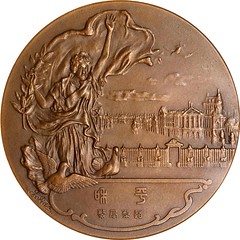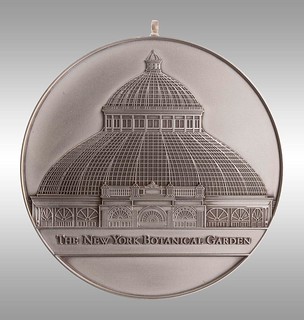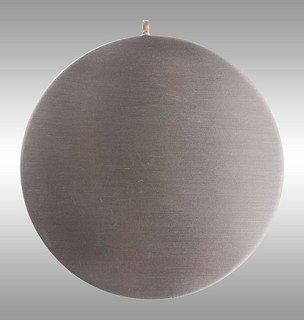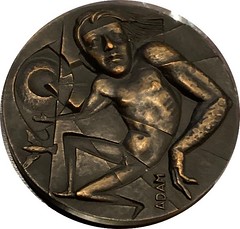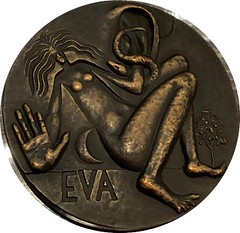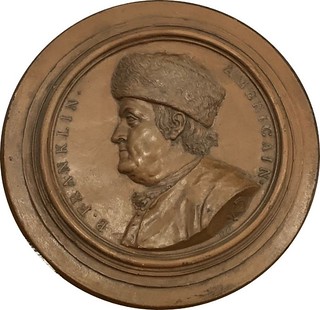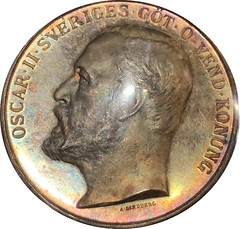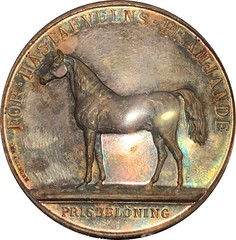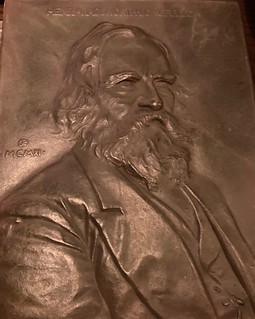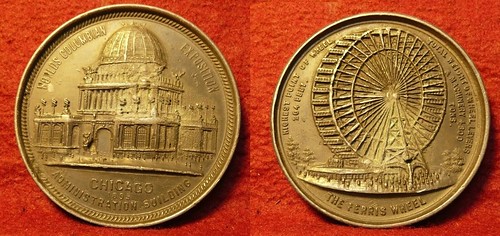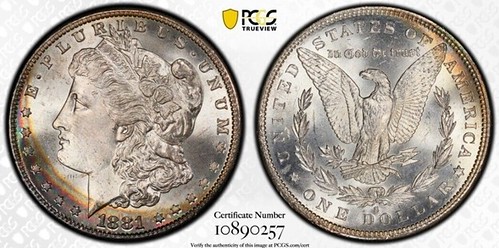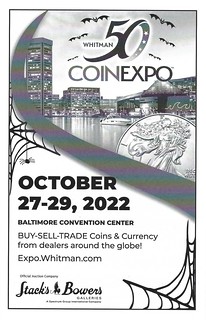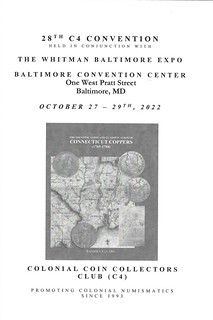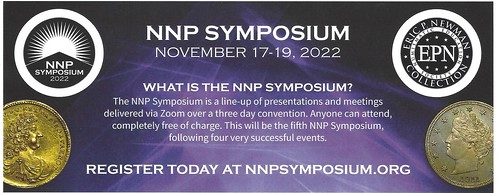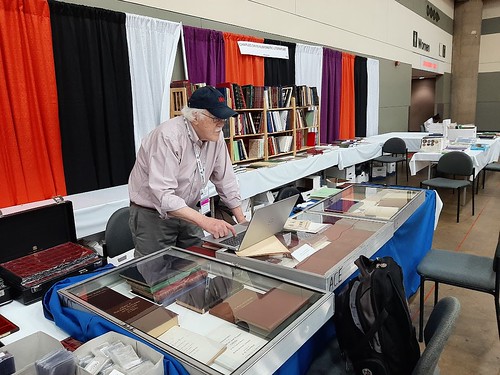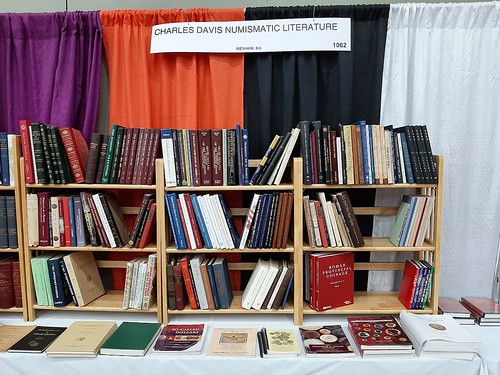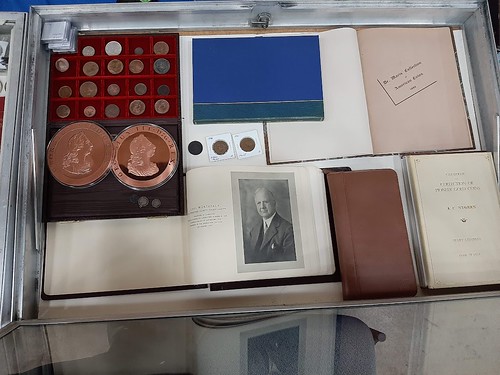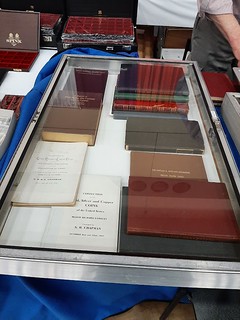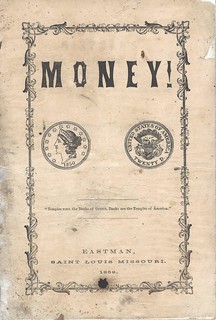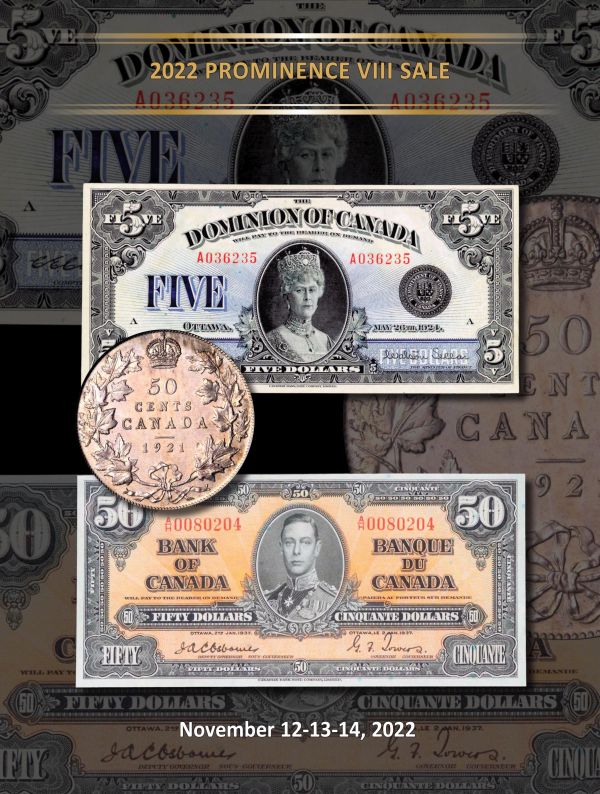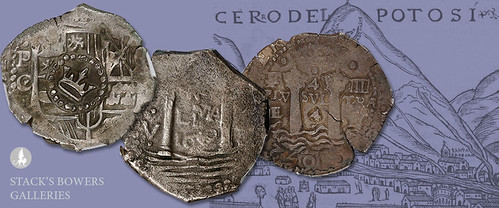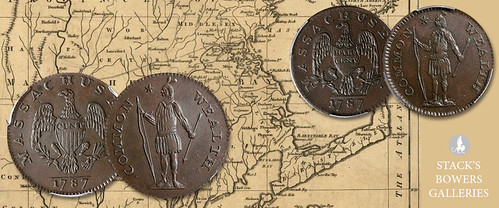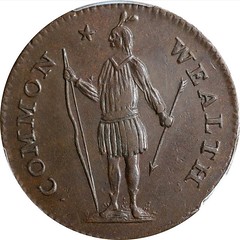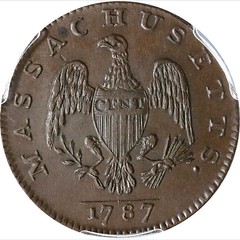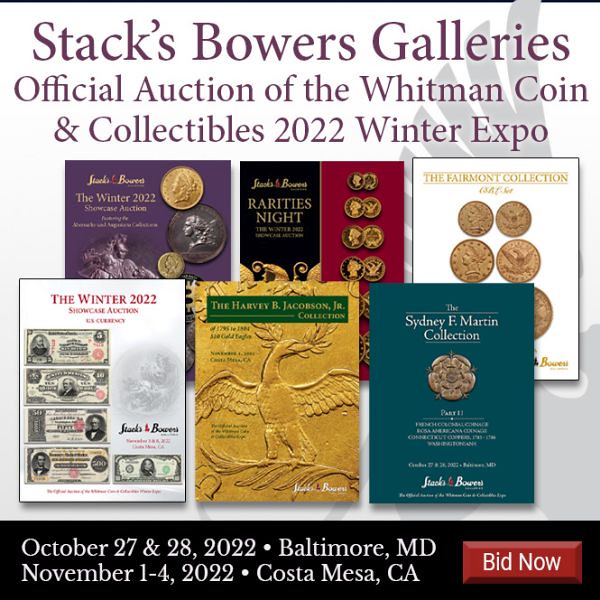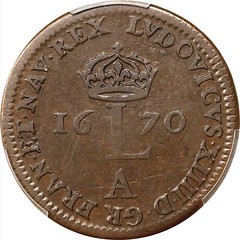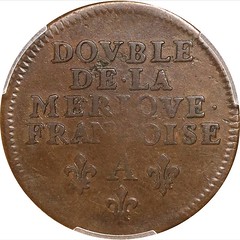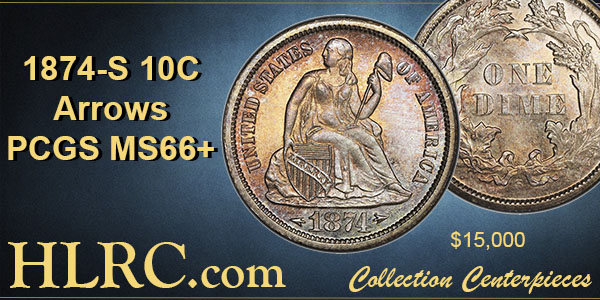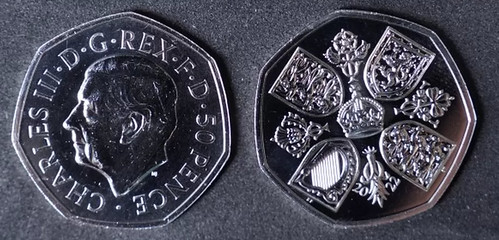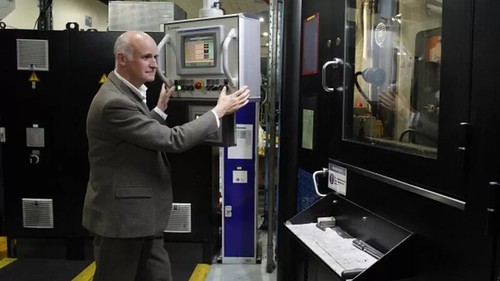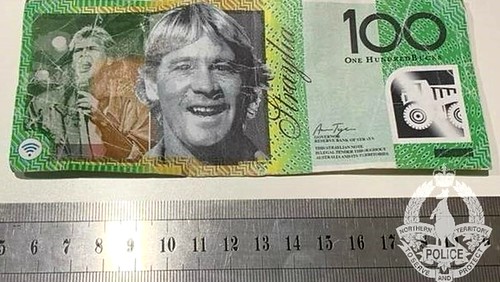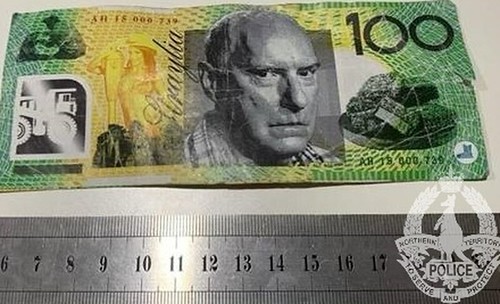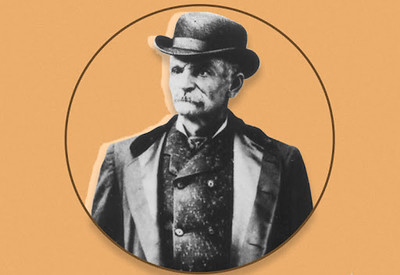
Visit our NBS Sponsors



About UsThe Numismatic Bibliomania Society is a non-profit association devoted to the study and enjoyment of numismatic literature. For more information please see our web site at coinbooks.org SubscriptionsThose wishing to become new E-Sylum subscribers (or wishing to Unsubscribe) can go to the following web page link MembershipThere is a membership application available on the web site Membership Application To join, print the application and return it with your check to the address printed on the application. Print/Digital membership is $40 to addresses in the U.S., and $60 elsewhere. A digital-only membership is available for $25. For those without web access, write to: Charles Heck, Treasurer AsylumFor Asylum mailing address changes and other membership questions, contact Chuck at this email address: treasurer@coinbooks.org SubmissionsTo submit items for publication in The E-Sylum, write to the Editor at this address: whomren@gmail.com BUY THE BOOK BEFORE THE COINSale CalendarWatch here for updates! |
- WAYNE'S WORDS: THE E-SYLUM OCTOBER 30, 2022
- NEW BOOK: CONFEDERATE NOTE SIGNERS
- NEW BOOK: THE PAPER MONEY OF EAST BAVARIA
- WRITING 100 GREATEST CANADIAN COINS AND TOKENS
- SKULL & CROSSBONES SMALL CHANGE NOTE
- VIDEO: FINANCIAL NEWS NETWORK 9-27-1983
- MORE ON DAVID LISOT
- NOTES FROM E-SYLUM READERS: OCTOBER 30, 2022
- HEBERDEN COIN ROOM 100TH ANNIVERSARY
- NUMISMATIC NEWS 70TH ANNIVERSARY
- VOCABULARY TERM: MATTE
- WILLIAM MORRIS MEREDITH (1799-1873)
- ATLAS NUMISMATICS OCTOBER 2022 SELECTIONS
- WRIGHT'S DECLARATION OF INDEPENDENCE MEDAL
- STEPHEN ALBUM INTERNET AUCTION 18
- ISLAMIC STATE COINAGE OFFERED
- HAYDEN 2022 TOKEN AUCTION SELECTIONS
- HERITAGE OFFERS 1755 SAFETY AT SEA MEDAL
- NUMISMATIC NUGGETS: OCTOBER 30, 2022
- TOM KAYS NUMISMATIC DIARY FOLLOW-UP
- WAYNE'S NUMISMATIC DIARY: OCTOBER 30, 2022
- C4 HONORARY LIFE MEMBER CHRISTINE KARSTEDT
- DEBASED SPANISH SILVER: THE "STAR OF LIMA"
- FIRST AMERICAN COIN WITH THE WORD "CENT"
- THE UNIQUE 1670-A DOUBLE DE L'AMERIQUE
- ROYAL MINT STRIKES KING CHARLES 50P COINS
- STAGE MONEY STOLEN IN AUSTRALIA
- STAGECOACH ROBBER BLACK BART THE POET
Click here to read the thin version on the web
Click here to subscribe
Click here to access the complete archive
To comment or submit articles, reply to whomren@gmail.com
Content presented in The E-Sylum is not necessarily researched or independently fact-checked, and views expressed do not necessarily represent those of the Numismatic Bibliomania Society.
WAYNE'S WORDS: THE E-SYLUM OCTOBER 30, 2022
Thank you for reading The E-Sylum. If you enjoy it, please send me the email addresses of friends you think may enjoy it as well and I'll send them a subscription. Contact me at whomren@gmail.com anytime regarding your subscription, or questions, comments or suggestions about our content.
This week we open with two new books, updates from the Newman Numismatic Portal, notes from readers, two impressive anniversaries, and more.
Other topics this week include Confederate Treasury Note signers, colonial small change notes, David Lisot, the Ashmolean Museum's Heberden Coin Room, matte finish, ISIS coinage, fixed price and auction previews, numismatic diaries, the Star of Lima, and the new King Charles 50 pence coin.
To learn more about the paper money of East Bavaria, the 100 greatest Canadian coins and tokens, a 1792 Half Disme not previously in the census, the Coronation Medal of Edward VI, the missing 1849 Double Eagle, the Gothic Crown, Charles Cushing Wright's Declaration of Independence medal, the Sea Serpent token, the New York Botanical Garden medal, the Ferris Wheel, Massachusetts coppers, the French Colonies Double de l'Amerique, and stagecoach robber "Black Bart the Poet", read on. Have a great week, everyone!
Wayne Homren
Editor, The E-Sylum
NEW BOOK: CONFEDERATE NOTE SIGNERS
A new book by Charles Derby and Michael McNeil delves into the lives and stories of the signers of Confederate Treasury Notes. Thanks to Paul Horner for passing this along - we got a peek at the book cover in the earlier articles about the PAN Civil War Showcase. -Editor
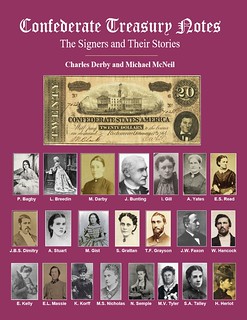 Confederate Treasury Notes. The Signers and Their Stories
Confederate Treasury Notes. The Signers and Their Stories
Charles Derby & Michael McNeil
• Introduction with a history of the Confederate Treasury Note Bureau and the professional activities of the Treasury note signers within it.
• Original research on the 371 signers of Confederate Treasury notes, some of whom also signed bond coupons. The book includes photographs of the signers and their lives.
• A section coupling an image of the signer's signature and name for quick identification of the signer on any Confederate note.
• A two-page list of the names of the signers for the Register and Treasury, updated from Thian's Register.
• Appendix with writings by and about the Treasury note signers.
• Extensive bibliography.
• Available as a 367 page soft cover book with perfect binding, 8 1/2 inch by 11 inch.
TO ORDER:
Send $49.95 plus postage ($5 domestic, $10 international) to:
Charles Derby, 204 Sycamore Ridge Drive, Decatur, GA 30030.
For more information, contact charlesderbyga@yahoo.com
NEW BOOK: THE PAPER MONEY OF EAST BAVARIA
Here's a Google-translated excerpt from an article by Hans Ludwig Grabowski on Geldscheine Online about a new book on the paper money of East Bavaria. -Editor
The paper money of East Bavaria
The emergency money in the area of ??today's districts of Cham, Regen and Straubing-Bogen
223 pages, format 21 cm x 29.7 cm,
Paperback, self-published, Cham 2022
ISBN: none
Price: 30.00 euros
Actually, it was "only" supposed to be an overview of the emergency money of the city of Cham in the Upper Palatinate, where the author was born and lives, but soon this was extended to the entire district and it didn't take long until two neighboring districts were added from Lower Bavaria were included in the work.
Such works can only come into being if dedicated homeland collectors have made painstaking efforts over many years to research the emergency money system in their region. Last but not least, the result is a complete color illustrated documentation of the paper money issues in three districts of Eastern Bavaria, which not only provides important background information with introductions to the various issues and a comprehensive description of all currently known issues and their variants, but also with numerous illustrations - too of the variants including detailed illustrations - documented.
Anyone interested in buying a book or supporting further research into paper money in East Bavaria, be it by reporting variants that have not yet been documented or by providing illustrations, please email the author directly: dietl.manfred@yahoo.de
To read the complete article, see:
Neuer Katalog: Das Papiergeld Ostbayerns
(https://www.geldscheine-online.com/post/neuer-katalog-das-papiergeld-ostbayerns)
WRITING 100 GREATEST CANADIAN COINS AND TOKENS
In this Whitman press release, author Dr. Harvey Richer discusses his experience writing his book, 100 Greatest Canadian Coins and Tokens. -Editor
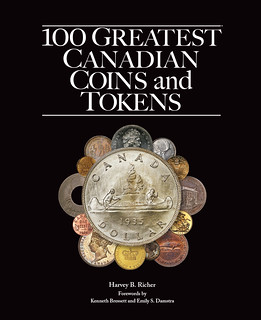 How does one choose the greatest coins and tokens of any country? A survey of experts? That would unquestionably turn up a huge diversity of results. Nevertheless, this was one route I took to establish Canada's top 100 coins and tokens. There is a society of active numismatic historians and writers in Canada, the Canadian Numismatic Research Society (CNRS), of which I am a member. Other affiliates who are likely well known to the general collecting community include Paul Berry, past curator of the National Currency Collection of the Bank of Canada; Brian Cornwell, founder of the ICCS grading service, which grades and encapsulates mainly Canadian coins; and James Haxby, author of the bestselling Whitman Guide Book of Canadian Coins and Tokens. This group is not composed of active coin dealers (although there are a few in the society). Their collecting and writing tastes generally run to more eclectic subjects, such as tokens and medals.
How does one choose the greatest coins and tokens of any country? A survey of experts? That would unquestionably turn up a huge diversity of results. Nevertheless, this was one route I took to establish Canada's top 100 coins and tokens. There is a society of active numismatic historians and writers in Canada, the Canadian Numismatic Research Society (CNRS), of which I am a member. Other affiliates who are likely well known to the general collecting community include Paul Berry, past curator of the National Currency Collection of the Bank of Canada; Brian Cornwell, founder of the ICCS grading service, which grades and encapsulates mainly Canadian coins; and James Haxby, author of the bestselling Whitman Guide Book of Canadian Coins and Tokens. This group is not composed of active coin dealers (although there are a few in the society). Their collecting and writing tastes generally run to more eclectic subjects, such as tokens and medals.
Early in the research for 100 Greatest Canadian Coins and Tokens, David Bergeron, the president of the CNRS and current curator of the National Currency Collection of the Bank of Canada, polled the members of the society at my suggestion, asking them to name up to five of their favorite coins and tokens related to Canada. A number of very useful suggestions were proffered by the group, and about half a dozen that I had not originally chosen were included in the final list. In the end, however, the choices were largely mine.
Those well versed in Canadian numismatics may find some of the entries in my anthology a bit odd, such as wampum belts, a U.S. encased postage stamp, a Government of Newfoundland $25 bond, a very common 1938 Newfoundland 1-cent coin, counterstamped Canadian dollars, and a number of high-mintage Canadian commemorative silver dollars. It may be fair to say some of these are not even coins or tokens, and as such do not belong. But each of these selections has a wonderful story to tell related to the development of Canadian coinage, and that is what most interested me in writing this book. Of course, all the high-priced, famous Canadian coins are here, too: the 1911 silver dollar, once called the world's most expensive coin; the gold $10 and $20 pieces from British Columbia; the 1890-H (the H
mintmark indicating that it was struck at the Heaton Mint in Birmingham, England) 50-cent coin; the 1893 Round Top 3 10 cents; the 1936 Dot coins; and the unique 2003 gold $1 coin, among others.
Instead of ordering the coins or tokens by some criterion of greatness (for example, recent auction prices or total number of examples known), I chose to produce a more or less chronological ranking. In this way, you can make historical connections between the various entries and follow, in a more continuous and comprehensive manner, the development of Canadian coinage from the earliest examples of wampum—used in trade among the Indigenous population and later with Europeans—all the way to Canadian coinage after Confederation, when Canada had its own mint and was a member of the British Commonwealth of Nations. All the physical specifications, auction details, pricing, and rarity information are included for each entry, but the narrative is a historical one.
While the title of my anthology is 100 Greatest Canadian Coins and Tokens, the book contains many more than 100 individual coins and tokens. This is because several coins and tokens have been treated in a single essay both for clarity and to reduce duplication. For example, each of the three 1936 Dot coins clearly deserves its own unique entry, but this would be unduly repetitive. Additionally, only a few examples of major varieties were included (for example, Flat Top and Round Top 1893 10 cents), and less dramatic varieties generally did not find their way into the final compilation.
Ranking the 100 Greatest Canadian Coins and Tokens
No one person should decide on the ranking of anything, let alone something as controversial as the 100 greatest coins or tokens of any country. Collectors have their own favorite areas regarding what appeals to them, from a historical perspective or because of scarcity or availability, while dealers often pursue those coins that they believe can be resold at a profit. These would introduce very different biases into the selection of the greatest coins and tokens, so I decided to let a knowledgeable cross-section of the community do this hard work for me.
I contacted a number of dealers and collectors whom I knew and asked them to contribute to the ranking process. The members of the Canadian Numismatic Research Society—the group mentioned above, of Canadians interested in the history and promotion of Canadian numismatics—were also asked to rank the entries in the book. I sent all these individuals a list of the 100 entries ordered more or less chronologically, as they currently appear in the book. The rules were few and simple:
1. No new additions allowed at this ranking stage.
2. At least 20 entries had to be ranked but, of course, more were preferred.
3. The top 100 Canadian coins and tokens were chosen from a list where a number 1 vote was worth 100 points, a number 2 vote 99 points, and so on. The weighted scores were then tabulated to produce the rank order of the entries.
Not surprisingly, the 1911 pattern silver dollar was ranked the number 1 Canadian coin or token—identical to its ranking in 100 Greatest Modern World Coins (by Charles Morgan and Hubert Walker). In fact, it would have been a surprise if the 1911 pattern dollar had not achieved this exalted position. (At one point it carried the moniker of the World's Most Expensive Coin.
) Ranked number 2 are the British Columbia gold coins of 1862, of which only eight are known of both denominations together. Entries 3 and 4 are the 1936 Dot set and the 1921 50-cent coin. Tokens and fiat money of various sorts fared very well, holding down nine spots among the top 20 entries.
I am indebted to the following individuals for providing their ranking choices and sharing their knowledge and experience with the collecting community: Darryl Atchison, David Bergeron, Sandy Campbell, Clément Chapados-Girard, John Deyell, Michael Findlay, Robert Forbes, Michael Joffre, Greg Jones, Robert Kokotailo, Svetolik Kovacevic, Warren Long, Oliver M., George Manz, Andrew McKaig, Barry Renwick, David Rubin, Dale Schaffer, Jared Stapleton, and Rob Turner.
David Bergeron, president of the Canadian Numismatic Research Society and curator of the National Currency Collection of the Bank of Canada. The Bank hosted a display of the greatest Canadian coins and tokens during the July 2022 RCNA convention. (Photo courtesy of Harvey Richer)
100 Greatest Canadian Coins and Tokens
By Harvey B. Richer; forewords by Kenneth Bressett and Emily S. Damstra.
ISBN 794849830. Hardcover, 10 x 12 inches, 160 pages, full color.
Retail $34.95 U.S.
To read the earlier E-Sylum article, see:
NEW BOOK: 100 GREATEST CANADIAN COINS AND TOKENS
(https://www.coinbooks.org/v25/esylum_v25n33a05.html)
SKULL & CROSSBONES SMALL CHANGE NOTE
Newman Numismatic Portal Project Coordinator Len Augsburger provided the following report. Thanks. -Editor
Skull & Crossbones Small Change Note
This Halloween-themed 1-penny small change note originates from Elizabeth, New Jersey, where it was printed by S. KOLLOCK
in 1790. Wikipedia identifies the printer (S. KOLLOCK
) as most likely Shephard Kollock, Jr. (1750-1839). Kollock published the New Jersey Journal during the Revolutionary War and later published proceedings of the New Jersey State legislature. Kollock also produced the 3, 4, and 6-penny notes of this date, although these do not depict the skull on the reverse. These notes served as paper coins,
and were suitably thick to allow for some degree of circulation. The use of a skull on paper money is uncommon, and perhaps acted as a reminder of the fleeting nature of life (and money too, in this context).
Image: Borough of Elizabeth, March 25, 1790, 1-Penny small change note. Fr. NJ-219. Ex. Newman Internet Sale 1 (Heritage Auctions, May 2016), lot 86410, realized $616.88.
Link to Early Paper Money of America (Newman Portal online edition):
https://nnp.wustl.edu/library/imagecollection/513468
VIDEO: FINANCIAL NEWS NETWORK 9-27-1983
The David Lisot Video Library on the Newman Numismatic Portal can be found at:
https://nnp.wustl.edu/library/multimediadetail/522852
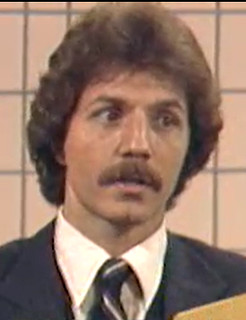 Continuing David's tradition, we'll highlight one of his videos each week in The E-Sylum.
Here's one of his first segments on the Financial News Network in September, 1983. It began with a show-and-tell format where David explained various collectibles from coins to matchbooks, then moved to a call-in format with viewers putting David on the spot with random questions.
-Editor
Continuing David's tradition, we'll highlight one of his videos each week in The E-Sylum.
Here's one of his first segments on the Financial News Network in September, 1983. It began with a show-and-tell format where David explained various collectibles from coins to matchbooks, then moved to a call-in format with viewers putting David on the spot with random questions.
-Editor
Financial News Network: Money Talk 9-27-83
David Lisot is interviewed as a collectibles expert and talks coins, antique advertising, cigar labels, matchbooks, and more. He takes questions from a national audience about different collectibles.
The video is also available for viewing on NNP at:
https://nnp.wustl.edu/library/book/584178
MORE ON DAVID LISOT
Tributes to the late David Lisot continue to arrive from readers. -Editor
Phil Iversen writes:
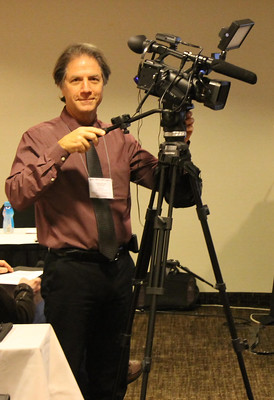 "I was both very surprised and saddened to learn of the recent passing of David Lisot whom I have known for many years.
"I was both very surprised and saddened to learn of the recent passing of David Lisot whom I have known for many years.
"I worked with both David and his father Larry for a while in the 1970s at his store called the COLLECTORIUM in Century City very close to the location of the Los Angeles Playboy Club. The store had a plethora of very interesting collectibles also including numismatic items available for sale. We went up to San Francisco to hold the first ever San Francisco Paper Money Show at a downtown Holiday Inn. One feature of the auction I fondly remember along with the currency were the numerous jumbo size and colorful circus posters being sold on consignment.
"I was a guest at his wedding that was held outdoors in a beautiful garden setting next to a lake and once received a phone call asking for a ride when his car broke down close to where I lived. Last year at the Long Beach Exposition I gave David a number of memorabilia items from those early years. I spoke with him and his fiance Debbie at the most recent show in Long Beach just a few weeks ago. He did a quick interview with me while filming other dealers and events that will now probably never be seen.
"David was a true gentleman in every way, very kind and caring with a free-spirited soul. His many contributions to the numismatic hobby were enormous. As a pioneer with vision for recording history we have all been graced by his presence for many years that have been cut way too short. RIP my good friend."
Richard Lobel of Coincraft writes:
"I was shocked to hear of the death of David Lisot, numismatics has lost one of its last unsung heroes and great numismatic biographers. He did more to record the coin business than anyone else I know. Dave Bowers has done a great job of writing about what happened in the coin business in the past - David Lisot recorded what was happening today. It will only be sometime in the future that historians realize what a fantastic group of work he has done. I don't believe that he ever ‘got rich' doing what he loved, but I for one appreciate his dedication.
"For the past 67 years that I have been in the coin business and because I have always dealt in world coins I have had the privilege to meet and get to know some great and ‘unique' dealers from all over the world. I first met David at a banknote fair in The Netherlands. He was carrying all his photographic equipment and getting interesting people to look into his camera and just talk about what they did and why. I found him both fascinating and unique.
"He was such a nice guy, I remember the first time I went to dinner with him, he asked if he could say grace before the meal. The coin business can be rough and tough and he was the first dealer ever to ask me that. He said grace and we had a most pleasant meal and I realized he was a straight shooter who was not afraid to be himself. Because he lived in the States and I live in London we didn't see each other all that often, but when we did it was always a pleasure. He did a lot for the numismatic industry and unfortunately the business never got around to appreciating his work enough. He was a numismatics biographer.
"I hope that some institution will buy his archive to preserve it and make it available to future numismatic researchers. I also hope they pay his family a lot of money, because his work is well worth it. He is almost like an artist whose work is not appreciated until after they are gone. Goodbye David - you will be missed."
David did come to an agreement with the Newman Numismatic Portal to store a large portion of his video archive and make it available to the public free of charge. -Editor
Steve Hill of Sovereign Rarities writes:
"I was so sad to read last weekend that my friend David Lisot had passed away from surgery complications – thank you so much for bringing this to wider attention.
"I was first acquainted with David when I used to work at A H Baldwin when he came and asked if he could film some cool coins
(one of his catchphrases) on our table at the ANA World's Fair of Money probably in 2009 in LA and from then onward he always came to film me speaking about cool coins from the UK at these annual events. I think we somewhat inspired him to come over and visit the UK for he then came to Coinex I believe in 2012 and we did some Coin Television spots at the show and in Baldwin, and David then came regularly to the UK for London Coins Fairs and Coinex for the next 18 months or so.
"I would continue to see David at every World's Fair of Money we were both in attendance at since, and would always have a pleasant conversation about all things to do with coins in the UK. Most recently of course in Rosemont in 2022 when we chatted and I said hi to Debbie. My deepest condolences to her and his family and regret I will not now ever see him wheeling the camera on its tripod up the aisle again as he would make a beeline for our table. Such a lovely gentleman and we should all be very grateful for the legacy of film he leaves for all to enjoy via the Newman Portal. He really was, as John Wilson said, like a Hollywood cameraman. I will miss seeing him."
Peter Preston-Morley of Noonan's writes:
"Like many of your subscribers I was shocked and much saddened to learn of the death of David Lisot. As John and Nancy Wilson said, he was a superb videographer. Quietly going about his business with courtesy and integrity, I came to know him better when he approached me at a NYINC show a number of years ago, enquiring whether it would be possible to video our British Numismatic Society meeting and host it on his cointelevision.com platform. Of course we were happy to accommodate him and he became a regular visitor to our meetings in New York, taping talks by David Guest, David Vagi and Robert Hoge, among others.
"I was about to contact him to advise that John Kraljevich would be our Society's guest speaker at the forthcoming NYINC in January. Sadly, that meeting will now be lacking David's presence, but we will be sure to remember him, and his contributions to numismatics, on the day."
David's funeral will be live streamed and the link will be on the Funeral Home website. The service will be held Monday, November 7, 2022 at 10:30 AM at St. Joseph Catholic Church, Richardson, TX. -Editor
To read the online obituary, see:
David Lawrence Lisot
(https://www.dignitymemorial.com/obituaries/dallas-tx/david-lisot-10971926)
To read a CoinsWeekly article, see:
David Lawrence Lisot (1953-2022)
(https://coinsweekly.com/david-lawrence-lisot-1953-2022/)
The American Numismatic Association has established a Young Numismatist Scholarship fund in David's name. -Editor
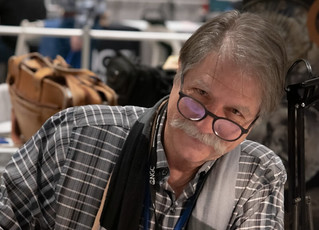 We are shocked and saddened by the sudden loss of numismatic media stalwart David Lisot, a familiar presence on the bourse and kind friend to us all.
We are shocked and saddened by the sudden loss of numismatic media stalwart David Lisot, a familiar presence on the bourse and kind friend to us all.
David used his camera to teach us about numismatics and the people in our community. His gentle, inquisitive spirit came through each show report and interview.
The ANA is establishing the David Lisot Memorial YN Scholarship to continue David's legacy of fascination with numismatics and numismatists themselves.
For more information, or to donate, see:
David Lisot Memorial YN Scholarship
(https://www.money.org/lisot-scholarship)
To read the earlier E-Sylum article, see:
DAVID LISOT (1953-2022)
(https://www.coinbooks.org/v25/esylum_v25n43a08.html)
NOTES FROM E-SYLUM READERS: OCTOBER 30, 2022
Bonham's 1792 Half Disme Lot Brings $113,775
A couple weeks ago Rob Luton passed along a lot from the October 25, 2022 Bonham's New York sale. The lot consisted of a printed broadside "Framed with small coin". The initial estimate for the document was $10,000 to $20,000. Rob noted the coin's resemblance to a 1792 Half Disme. I corresponded with the auction house as well as Pete Smith and Joel Orosz, co-authors of 1792: Birth of a Nation's Coinage. As it turned out, the coin was indeed a 1792 Half Disme not previously in the census, slabbed and graded VF 35 by NGC. The estimated range for the lot was raised to $20,000 to $30,000. So how much did the dual lot bring? -Editor
Rob writes:
"I would say $113,775 is no small sum… I guess the consignor is not going to send me a thank you note as they don't know who I am but I take a little bit of pride, as you should, in their successful sale. Well done."
Thanks again to Rob, Pete and Bonham's for their help getting to the bottom of that "small coin" with no small pricetag in today's market. Great find, and congratulations to the new owner, whom we expect will have the piece reslabbed.
This was one of the more rewarding articles we've published, and one of my all-time favorites, along with the series we did on the coinage of ISIS a few years back (see a new article elsewhere in this issue). E-Sylum readers are the best. Double thanks to Pete Smith for his image analysis and 1792 Half Disme census data. -Editor
To read the earlier E-Sylum article, see:
ESTABLISHMENT OF THE MINT AND 1792 HALF DISME
(https://www.coinbooks.org/v25/esylum_v25n42a13.html)
Hopi Prayer for Rain Medal
Daniel Fearon writes:
"I was interested to see the illustration of Hermon MacNeil's 'Hopi / Prayer for Rain' medal taken from the new book Hermon Atkins MacNeil : American Sculptor in the Broad, Bright Daylight", by James E. Haas. However, the caption seems to muddle it with his award medal for the Pan-American Exposition in Buffalo, 1901, whereas the Hopi medal was issued by the Society of Medallists in 1931, 30 years later. Both are cracking medals and are also illustrated by Barbara A. Baxter in
The Beaux-Arts Medal in America
, Fig. 5 / no. 106 and no. 354."
Above is the Pan-American Exposition medal; Below is the Hopi Prayer for Rain medal. The confusion may have come from my back-to-back layout. I used the captions embedded in the image files. -Editor
To read the earlier E-Sylum article, see:
NEW BOOK: HERMON ATKINS MACNEIL
(https://www.coinbooks.org/v25/esylum_v25n43a02.html)
New Interview With CAC's John Albanese
John Feigenbaum of CDN Publishing posted a second video interview with CAC's John Albanese about the firm's pivot to third-party grading. Hobby history happening in real time. Check it out. -Editor
John Feigenbaum scores a second exclusive interview with the CAC founder. This time we address many of the viewer questions from our first session.
To watch the interview, see:
The Second Interview with CAC's John Albanese: Questions Answered and New CAC Slab Revealed
(https://www.greysheet.com/news/story?title=the-second-interview-with-cac-founder-john-albanese-questions-answered-and-new-cac-slab-revealed)
To read the earlier E-Sylum article, see:
CAC BECOMES A THIRD-PARTY GRADING COMPANY
(https://www.coinbooks.org/v25/esylum_v25n42a20.html)
HEBERDEN COIN ROOM 100TH ANNIVERSARY
Gil Parsons writes:
"This week marks the hundredth anniversary of the opening of the Heberden Coin Room at the Ashmolean Museum at Oxford. The university sent out a highly interesting report. The place is a fabulous resource!!"
Thanks. The department was undergoing renovations during my trip to Oxford in 2007, so I was unable to visit. Great article - here's an excerpt; see the complete article online. -Editor
Since its public opening on 24 October 1922, the Ashmolean Museum's Heberden Coin Room has grown to become one of the world's leading coin cabinets. The original collection of 60,000 coins and medals has expanded significantly and the coin room now houses some 300,000 items, including paper money, tokens, jettons and commemorative art medals.
Generous donations have played a crucial role in supporting the work of the Heberden Coin Room over the years: they have underpinned the growth of the collections and their display and digitisation, as well as ambitious research projects, visiting scholar programmes and public events.
To celebrate the centenary, we're taking a closer look at six recent gifts that are helping to bring the world of numismatics to life for students, scholars and members of the public around the globe.
Did you know? The opening of the coin room was the culmination of a forty-year campaign, finally enabled by a bequest of £1,000 from Charles Heberden, Principal of Brasenose College. He had left the money for any University purpose and so had no idea that he was helping to found a coin room!
Revealing new details about life in the Late Iron Age
An exquisite collection of more than 1,000 coins was donated to the Ashmolean Museum earlier this year by collector and scholar Dr John Talbot, under the Arts Council's Cultural Gifts Scheme. The collection contains ornately designed gold and silver coins minted by the Iceni, an Iron Age community that inhabited present-day East Anglia — perhaps best known for their famous ‘queen' Boadicea.
The coins preserve the earliest writing by the Iceni and bear captivating and intricate imagery depicting a wide range of motifs, from wolves and prancing horses to spiky-haired boars and hidden faces. These speak of many key aspects of Iron Age life: art and iconography; tribal identities; and the changing nature of kingship.
A sliver unit from c. 30BC. The head on the obverse has locks of hair and ornate bands across the forehead. When the coin is turned, the lock of hair becomes a second eye, revealing a hidden face. On the reverse, a prancing horse is shown with ‘sun' motifs © Ian R Cartwright, Institute of Archaeology, Oxford University
Dr Talbot's donation will have a major impact on the Ashmolean's Iron Age coin collection. It includes every known type of Icenian coin (in many cases the finest known example) and will nearly double the number of so-called ‘Celtic' coins held by the museum. With much information still to be extracted, it promises to be an extraordinary new resource for those interested in Late Iron Age Britain and the culture of the Iceni.
Acquiring a national treasure
Towards the end of 2021 the Heberden Coin Room acquired a remarkable coronation medal made for the accession of nine-year-old Edward VI, following the death of his father King Henry VIII in 1547. It was engraved by Henry Basse, chief engraver at the Tower Mint, and features an intricate portrait of Edward in armour with insignia. Text highlighting Edward's temporal and spiritual powers and his young age appears in Latin, and again in Hebrew and Greek on the reverse.
‘Coronation Medal' of Edward VI (1547–53), 1547, Tower Mint, London, with dies by Henry Basse. Silver, struck, 6.5cm. Ashmolean Museum (HCR95030) © Ashmolean Museum, University of Oxford
The quality of the medal indicates that it was part of the original production, struck in silver at the Tower of London for the occasion of the ceremony, and not one of the many later re-strikes or re-casts. The same can only be said for one other specimen — now in St Petersburg — and so in this sense the museum has undoubtedly been able to acquire a national treasure.
This fantastic acquisition was made possible through the support of the Arts Council England/V&A Purchase Grant Fund, the Art Fund, the generosity of Richard and Gabrielle Falkiner and an anonymous donation in the memory of Professor D M Metcalf.
Sharing the joy of Roman provincial coinage
The Ashmolean Museum's Roman Provincial Coinage (RPC) project is one of the most important research projects in numismatics, generating invaluable information about how the Roman Empire established power and governed — and how the provinces responded. RPC online currently features more than 400,000 coins from 70,000 types, and draws in several million views each year, proving its impact beyond academia.
To help the project achieve even more the Ashmolean launched a fundraising appeal earlier this year, so far raising over £30,000 to underpin its ambitious work and enable it to share the joy of Roman provincial coins with an even wider audience.
To read the complete article, see:
Celebrating the centenary of the Heberden Coin Room
(https://oxfordgiving.medium.com/celebrating-the-centenary-of-the-heberden-coin-room-736a01a20355)
NUMISMATIC NEWS 70TH ANNIVERSARY
Numismatic News Editorial Director Maggie Pahl published this article introducing the publication's 70th anniversary issue. Congratulations! -Editor
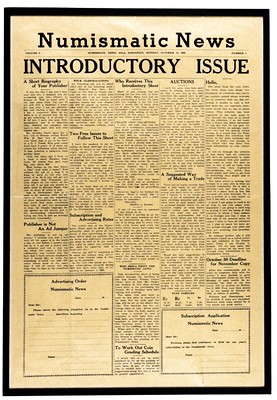 Welcome to this special week of celebrating the 70th anniversary of Numismatic News! Shown [here] is the debut issue of the magazine, datelined October 13, 1952, in its entirety. In an introductory message to readers aptly headlined,
Welcome to this special week of celebrating the 70th anniversary of Numismatic News! Shown [here] is the debut issue of the magazine, datelined October 13, 1952, in its entirety. In an introductory message to readers aptly headlined, Hello,
founder Chet Krause wrote from the dining room table of his family home in rural Iola, Wis., Far away from the coin clubs, far away from coin shops, live thousands of collectors who rarely see another person whose interests are in harmony with his.
He continues, It will be through the columns of this paper that all collectors will have an opportunity to trade and correspond with one another from coast to coast.
His sign-off includes the following: So without further ado, I will introduce myself as a fellow collector and publisher of the Numismatic News. I am Chester L. Krause.
And so Numismatic News was born. A single page, written by a man who included himself among the collectors for whom he was creating it.
There is so much one could say about this magazine – how it has evolved and how much valuable collecting content it has provided its readers – but at the heart of it, Numismatic News was created for the collector by a collector. Chet Krause's original vision has been the guiding force throughout the publication's seven decades of existence.
Many things have changed in the coin hobby and publishing landscapes over the years: the way we deliver content to the reader, the use of technology, ways of collecting. But the one thing that hasn't changed is that the collector remains at the center of it all.
Numismatic News has always valued and served collectors' passion for the hobby, their appetite for news, history, and collecting tips and, most importantly, their need for connection. We recently asked readers to share their stories of getting started in coin collecting, and it was striking how many responses focused on the who rather than the what. Who got them interested, who they've met along the way. Yes, coins are the objects we collect, but it is the relationships and shared experiences that breathe life into our hobby.
We at Numismatic News are honored for the role we have played in fostering those connections through letters to the editor, weekly poll questions, social media platforms and more. We are proud to bring together people whose interests are in harmony.
Finally, none of these 70 years would have been possible without our readers. Thank you, on behalf of our staff present and past, for contributing to the vitality of this magazine and for sharing your passion with us. It's all for you.
To read the complete article, see:
Numismatic News: 70 Years in the Making
(https://www.numismaticnews.net/us-coins/numismatic-news-70-years-in-the-making)
Below are links to additional articles from the anniversary issue. -Editor
To read the complete articles, see:
70 Years of the ‘News' a Publishing Feat
(https://www.numismaticnews.net/us-coins/70-years-of-the-news-a-publishing-feat)
Numismatic News: A Walk Down Memory Lane
(https://www.numismaticnews.net/us-coins/numismatic-news-a-walk-down-memory-lane)
VOCABULARY TERM: MATTE
Here's another entry from Dick Johnson's Encyclopedia of Coin and Medal Terminology. See the Numismatic Nuggets article in this issue for an image of a Japanese End of World War I Bronze Medal with a matte finish. -Editor
Matte. A dull unburnished metallic finish without luster or sheen; an area of dead reflection. Matte surface, infrequently called mat surface, is produced by abrasive blasting with sand (or other grit abrasive), by matte dip (an acid that lightly etches the metal surface), or by matting tools (more often used in chasing). Matte finish is often used with proof surface for the contrast of reflectiveness – the main device is usually matte with the background or field in proof. Such dies are made by first masking the portion to have a proof surface, applying the matte dip to the area for the dead reflection, removing the masking material, then proof polishing the area to have the mirror surface. The contrast is quite startling. See reflectiveness, proof finish.
Matte finish on gold is called rose gold, this is not a color of gold, but a ruddy, matte finish of gold. It has no luster, but has the finish, it is said, of a rose petal.
To read the complete entry on the Newman Numismatic Portal, see:
Matte
(https://nnp.wustl.edu/library/dictionarydetail/516277)
WILLIAM MORRIS MEREDITH (1799-1873)
American Numismatic Biographies author Pete Smith submitted this article on Treasury Secretary William Meredith, a missing rare coin, and altered fractional currency portraits. Thanks! All great topics. -Editor
One of America's rarest and potentially most valuable pattern coins is missing. This week we offer some clues to the disappearance of the only 1849 double eagle in private hands.
William M. Meredith was born in Philadelphia on June 8, 1799, the son of attorney William Tuckey Meredith (1777-1844) and Gertrude Gouverneur Ogden (1777-1828). Gertrude was the niece of Gouverneur Morris (1752-1816) who is credited for his proposal for a decimal system of American coinage.
The son graduated from the University of Pennsylvania with a bachelor's degree at a young age in 1812 and master's degree in 1816. He read law until he was admitted to the Pennsylvania bar in 1817 at age 18. He then practiced law when he was not in an elected position. Meredith was elected to the Pennsylvania General Assembly and served 1824 to 1828. He served on the Philadelphia City Council from 1834 to 1849 and was a delegate to the 1837 Pennsylvania Constitutional Convention. He campaigned for Whig candidate William Henry Harrison and was rewarded in 1840 with an appointment as attorney for the Eastern District of Pennsylvania.
Meredith was quick to finish his education but slow to get married. After a ten-year engagement, he married Catherine Keppele (1801-1853) on June 17, 1835. They had a son and four daughters.
He was an unsuccessful Whig candidate for the Senate in 1848. President Zachary Taylor appointed Meredith Secretary of the Treasury and he began his service on March 8, 1849. President Taylor died on July 9, 1850, and Meredith resigned, effective on July 22 having served a little more than sixteen months in the position.
Gold was discovered at Sutter's Mill in California on January 24, 1848. Soon large quantities of gold were shipped back to Philadelphia for conversion into coinage. Congress voted on March 3, 1849, to issue $20 gold coins to be called double eagles. James Barton Longacre produced dies and at least two pieces were struck on December 22, 1849. One was set aside for the Mint Cabinet and the second was sent by Mint Director Robert M. Patterson to Secretary Meredith for his examination and approval. The 1849 pattern pieces were in high relief and could not be properly struck in the mint presses. New dies in lower relief were prepared for coinage in 1850.
After leaving Mint service, Meredith returned to the practice of law and changed his party to Republican in 1854 as the Whig party was dissolving. He was elected Pennsylvania attorney general and served in that position from 1860 to 1867. In 1872, was president of the Republican National Convention.
Meredith died on August 13, 1873, and is buried with his wife at Christ Church Burial Ground. That cemetery is the final resting place of Benjamin Franklin and is across the street from the current Fourth Philadelphia Mint.
A photograph shows the 1849 double eagle in the Meredith estate. Subsequent ownership is uncertain. Walter Breen states that it was handled by dealer Stephen K. Nagy and went into a private collection. Nagy (1884-1958) was born ten years after the death of Meredith and ownership between Meredith and Nagy is untraced. If Breen is correct, This could be in a multi-generation collection where the owner knows what they have. It could also be sitting in a collection unappreciated or it may have been lost.
I do not own the missing 1849 double eagle. As a literature collector, I own three books with the 1849 double eagle embossed on the cover. These include Montroville Wilson Dickeson's The American Numismatical Manual, 1859; George Evans' History of the United States Mint and American Coinage Ancient and Modern, 1891 edition; and Isaac Smith Homans The Coin Book, 1872. The Dickeson and Homans covers have the obverse slightly overlapping the reverse. Both were published by J. B. Lippincott & Co. in Philadelphia.
A Mathew Brady photograph of Meredith may be as rare as an 1849 double eagle. An engraved portrait of Meredith, made from the Brady daguerotype, appears on a ten cent fractional currency note, fifth series, issued six months after his death February 26, 1874, and continued through February 15, 1876. This portrait became a popular base for artistic alterations.
I scanned two pieces from my collection. The first is the portrait as issued without alteration. The second shows a piece altered with black and red ink to represent some type of religious figure. This was probably not intended to represent a specific person.
The E-Sylum of October 16, 2022, showed a Meredith portrait altered to represent Boss
Tweed. This was the inspiration for me to look for alterations on the internet. I produced a
composite picture showing six examples out of about twenty I found.
Each of these may be a unique work of art. Similar pieces are not common but are also not rare. I can't explain why the Meredith portrait was so popular for alteration. I suspect some people saw examples and were inspired to try their own. The initial examples can't be identified but then the whimsy spread like a virus to others.
I would be interested to hear from any E-Sylum reader who has formed a collection of these.
Can anyone help? I wouldn't be surprised if other readers collect these, too. -Editor
To read the earlier E-Sylum article, see:
BOSS TWEED CARICATURES
(https://www.coinbooks.org/v25/esylum_v25n43a12.html)
THE BOOK BAZARRE
ATLAS NUMISMATICS OCTOBER 2022 SELECTIONS
Atlas Numismatics has updated their website with 397 new coins, medals, and tokens at fixed prices. Beautiful pieces! Selections include the following items. -Editor
Gem Mint State Lucius Verus Aureus
1071141 | ROMAN IMPERIAL. Lucius Verus. (Emperor, 161-169 AD). Struck 163 AD. AV Aureus. NGC Gem MS (Gem Mint State) Strike 5/5 Surface 5/5 Fine Style. Rome. 7.26gm. L'VERVS AVG - ARMENIACVS. Bare head, right / TRP IIII ' IMP II COS II. Victory standing right holding inscribed shield, VIC/ AVG. Cohen 248; Calico 2174.
Ex. Fernand David Collection.
$44,500
To read the complete item description, see:
https://atlasnumismatics.com/1071141/
Choice Double Mouton d'Or
1069264 | BELGIUM. Brabant. Joanna and Wenceslas. (Duchess and Duke, 1354-1383). (1355-83) ND AV 2 Mouton d'Or. NGC MS63+. Vilvorde mint. 6.23gm. + AGn o D?I o QVI o TOLL' o PCCA o MVDI o MIS?R?R? o nOB. Nimbate Agnus Dei left, head right, a long cross with banner behind; all within a tressure broken by IOh' DVX in the exergue / + XP'C : VI?CIT : XP'C : R?G?AT : XP'C :. Cross fleurée with lis in angles; all within a quadrilobe with lis in spandrels. Fr.-7; Delmonte 44.
Sharply struck and lustrous, a superb example of this rare type. $28,500
To read the complete item description, see:
https://atlasnumismatics.com/1069264/
Attractive Volcano Peso
1070842 | CHILE. 1822 FI AR Peso. PCGS MS63. Santiago Mint. Volcano / Y to left of pillar. KM 82.2; WR-7; Elizondo-87. $11,500
To read the complete item description, see:
https://atlasnumismatics.com/1070842/
Virtually Flawless 1793 24 Livres
1071146 | FRANCE. L'An II//1793-W AV 24 Livres. NGC MS66+. Lille. 7.61gm. •REPUBLIQUE FRANÇAISE•. Denomination within wreath; date below / REGNE DE LA LOI ·. Standing Genius writing the Constitution. KM 626.5; Gadoury 62.
Superb and exceptional; likely the finest surviving example of the type.
Ex. Fernand David Collection.
To read the complete item description, see:
https://atlasnumismatics.com/1071146/
Exceptional German New Guinea Proof 5 Mark
1071042 | GERMAN NEW GUINEA. 1894-A AR 5 Mark. NGC PR66. Berlin. Denomination and date in palm wreath / Bird of Paradise. KM 7; Jaeger 707. $89,500
To read the complete item description, see:
https://atlasnumismatics.com/1071042/
Lovely Gothic Crown
1071418 | GREAT BRITAIN. Victoria. (Queen, 1837-1901). 1847 AR Gothic Crown. PCGS PR65 Cameo. Royal mint. Edge: UN DECIMO. VICTORIA DEI GRATIA BRITANNIAR. REG: F:D. Crowned bust left / TUEATUR UNITA DEUS, ANNO DOM MDCCCXLVII. Crowned shields of England, Scotland and Ireland in cross formation with flowers at corners. KM 744; SCBC-3883; ESC-2571 (Prev. ESC-288); Dav.-106.
The Gothic Crown is considered one of the most beautiful coin types of British coinage. $97,500
To read the complete item description, see:
https://atlasnumismatics.com/1071418/
Updates to their online inventory are issued monthly. For more information and to sign up for the firm's monthly newsletter, visit: atlasnumismatics.com
WRIGHT'S DECLARATION OF INDEPENDENCE MEDAL
Sedwick Auctions is offering an important medal by Charles Cushing Wright in their upcoming sale closing November 4, 2022. Here's an excerpt from the lot description. -Editor
USA, proof silver medal, Declaration of Independence (struck in the 1850s), by Charles Cushing Wright, unique in silver, NGC MS 62 [sic], ex-Bushnell, ex-Garrett, ex-Adams. Musante GW183; Baker (Rulau-Fuld) 53G. 91mm; 259.0 grams. NGC 6481717-001. Pedigreed to the John Adams Collection, with entire ownership pedigree dating back to Charles Ira Bushnell (Chapman auction of June 1882, lot 1274), Garrett Estate (Bowers & Ruddy auction of April 1981, lot 1910), Julian Leidman (Bowers & Merena auction of April 1986, lot 4126), and Charles A. Warton (Stack's Bowers auction of March 2014, lot 2077), subsequently purchased by Adams in the Stack's Bowers auction of August 2018 (lot 46). Estimate: $25,000-up.
Manmade beauty comes in many forms. As numismatists we discern artistic beauty in a handheld piece of history. The beauty of a coin or medal starts with its engraver; next its striking, which is critical as a bad strike can ruin a beautiful design. Finally, the toning of the metal, which takes many years to happen, is a process over which we have much less control. For some pieces, there is one final distinction, a coup de grâce known as pedigree, for only a piece that was held and admired by the greatest collectors can have such psychological beauty.
When this medal was designed and struck sometime in 1852 to 1854 by Charles Cushing Wright, only a bronze version was advertised, first published in Norton's Literary Letter in 1857. The first auction appearance of one of these bronzes (of which only two to four are known today), was in the Edward Cogan (Philadelphia) sale of March 25-26, 1862, from a collection billed as The Property of a Private Gentleman [John K. Wiggan], Collected Without Regard to Expense,
lot 757, described as extremely rare
(consider how many ten-year-old numismatic items today could be considered extremely rare
). The next known auction offering of a bronze example was in June 20-24, 1882 (lot 1275), when the Chapman Brothers (Samuel Hudson Chapman and Henry Chapman, also in Philadelphia) handled the collection of the estate of Charles Ira Bushnell, the medal again described as extremely rare,
but with a note that it was the same as the lot above it, lot 1274, in silver. That lot was the same silver piece you see now, with a brief description ending in Silver. Proof. Unique in this metal.
Why did they believe it was unique? The answer lies in the owner, Bushnell, who was a known patron of Wright's work and presumably had it struck for himself as a specimen. It is inconceivable that the Chapmans would have made that assertion if Bushnell himself had not told them. Note it was also described as Proof by the Chapmans, another term that they would only state if true (a fact that was recognized by PCGS when this piece was graded as SP63 by that firm, its current designation of MS 62 by NGC a bit indefensible).
The design itself was not unique, however. Not only were there identical versions in bronze, as noted, but also its scene of the presentation of the draft of the Declaration of Independence to the Continental Congress on June 28, 1776 (based on the famous 1818 painting by John Trumbull that hangs in the rotunda of the U.S. Capitol and graces the back of our $2 bill) was used by Wright to make other medals with the bust of George Washington on the other side. It is interesting to note that even as long ago as 1882 the Chapman Brothers erroneously described this scene as the signing of the Declaration of Independence, whereas in fact the image shows the five-man drafting committee (consisting of John Adams, Richard Sherman, Robert R. Livingston, Thomas Jefferson, and Benjamin Franklin) presenting their draft to a seated John Hancock. Each man pictured in the scene was a real person, 47 in all, of which 42 were actual signers of the Declaration (fourteen signers were not depicted, as Trumbull could not find accurate likenesses of them, the remaining five extras
being luminaries who were present for the debates but not for the signing). The scene itself, however, is a fantasy, as these 47 men were never all in that room at the same time, that room
being none other than Independence Hall in Philadelphia. It is amazing how well the painting lent itself to a medal format, the depth of perspective and finely detailed portraits faithfully rendered down to the last detail, even showing the right foot of the preternaturally tall Jefferson almost stepping on the comparatively short Adams' left foot, once believed to have been symbolic of their legendary post-Independence rivalry. Above the scene is DECLARATION / OF and below is INDEPENDENCE and the date of the signing, July 4, 1776.
The other side of the medal bears a square tablet with a veritable curriculum vitae of the United States, listing eighteen events that led up to the momentous occasion of our Independence, as follows:
DISCOVERY OF NORTH AMERICA BY THE ENGLISH.JLY.3.1497
DISCOVERY OF FLORIDA BY THE SPANIARDS.APRIL.6.1512
FIRST SETTLEMENT IN VIRGINIA. MAY. 23.1607
HUDSON RIVER DISCOVERED BY THE DUTCH.SEP.21.1609
DUTCH SETTLEMENT AT NEW YORK.1614
LANDING OF THE PILGRIMS AT PLYMOUTH.DEC.22.1620
FIRST WAR WITH THE INDIANS (PEQUOTS) 1637
UNION OF THE NEW ENGLAND COLONIES.MAY.29.1643
NEW YORK TAKEN BY THE ENGLISH.OCT.4.1664
WAR WITH THE FRENCH AND INDIANS.1754
TREATY OF PEACE BETWEEN FRANCE & ENGLAND.FEB10.1763
STAMP ACT PASSED IN ENGLAND.MARCH22.1765
STAMP ACT CONGRESS MEET AT NEW YORK.OCT7.1765
MASSACRE OF AMERICANS AT BOSTON.MARCH.5.1770
FIRST CONTINENTAL CONGRESS AT PHILADA SEP.5.1774
FIRST REVOLUTIONARY BATTLE AT LEXINGTON.APRL.19.1775
BATTLE AT BUNKERS HILL.JUNE.17.1775
ASSAULT ON QUEBEC BY AMERICANS.DEC.31.1775
Scenes at top and bottom depict a small boat of Europeans landing at a rocky promontory guarded by an Indian (often described as Columbus' landing in the New World, but that is doubtful considering the list of events) above, and a wharf scene with building, ships and lighthouse at bottom (perhaps Boston Harbor, but the design of the lighthouse is different). As with the other side, the artistry is par excellence.
Well designed and well struck, yes… but the third aesthetic factor is the icing on the cake: As a silver medal, this piece was subject to whatever mysterious chemical forces cause colorful toning on silver only, such that in the right light the surfaces positively radiate with a supernova burst of blue, green, purple and golden orange, all with underlying luster from proof-quality preparation. The wire rims are high, with just a small nick or two, and the struck details are thoroughly raised and devoid of weakness or wear. Much like the Liberty Bell, this gem bears a dignified flaw in the form of a meandering die-crack, from just right of the top to the middle on the reverse (considered a possible explanation for the extreme rarity of this issue), in addition to a small flaw or mark just to the right of the date 1643 and faint hairlines that any medal like this would have, all mere beauty spots on the alabaster countenance of a proper lady.
But as we said, there is one more quality that creates psychological beauty, a pride of ownership achieved by the desire to fight to own something so pleasing in artistry and preservation, namely its pedigree. Here we can trace this very same medal from its sponsoring first owner, Bushnell; thence to T. Harrison Garrett and his son, John Work Garrett, whose collection was sold by Bowers & Ruddy, this piece auctioned as lot 1910 in Part 4 (April 26, 1981); subsequently sold by Bowers & Merena as part of the Julian Leidman Collection on April 12, 1986 (lot 4126); next in the Charles A. Wharton Collection auctioned by Stack's Bowers Galleries March 26-April 1, 2014 (lot 2077), where it was finally given the entire page it deserved; and finally the Stack's Bowers auction of August 22, 2018, this time on the cover of the catalog and monopolizing two pages, as lot 46. The buyer in that auction was our own John Adams, in fact an indirect descendant of the John Adams who is shown front and center
on this medal—what a fitting pedigree! But as any seasoned numismatist knows, it is not we humans but the items we collect that live on, and now this monumental opus will find a new home. Surely its next pedigree will be another name of collecting distinction.
To read the complete lot description, see:
USA, proof silver medal, Declaration of Independence (struck in the 1850s), by Charles Cushing Wrigh
(https://auction.sedwickcoins.com/USA-proof-silver-medal-Declaration-of-Independence-struck-in-the-1850s-by-Charles-Cushing-Wrigh_i46544986)
To read the earlier E-Sylum article, see:
SEDWICK TREASURE AUCTION 32 ANNOUNCED
(https://www.coinbooks.org/v25/esylum_v25n42a25.html)
STEPHEN ALBUM INTERNET AUCTION 18
Here's the announcement for the November 2022 internet auction from Stephen Album Rare Coins. -Editor
Stephen Album Rare Coins will hold its Internet Auction 18 at its offices in Santa Rosa, California on November 7-8, 2022. Internet pre-bidding has already begun and can be accessed through the auction house's website. The Auction is made up of 2000 lots of coins from all categories and time periods. There is a wide range of value in the sale including items from $50 all the way up to $12,000 for a rare British Indian rupee dated 1939. Additional highlights include rare proofs of British India, difficult to find medieval Islamic rarities as well as general worldwide A-Z collector coins in choice condition.
Some highlights of the sale follow:
LOT 979 BRITISH INDIA: George VI, 1936-1947, AR rupee, 1939(b), KM-555, small lamination error on obverse, a lustrous attractive example of a very rare date! NGC graded AU58 $10,000 to $12,000
LOT 925
BRITISH INDIA: Victoria, Empress, 1876-1901, AR ½ rupee, 1897-B, KM-491, hint of 7/6 overdate, a lovely early
restrike quality example! NGC graded Proof 63, ex David Fore Collection
$2,400 to $2,600
LOT 974
BRITISH INDIA: George VI, 1936-1947, AR rupee, 1938(c), KM-555, an attractive lustrous proof restrike example!
NGC graded Proof 61
$2,200 to $2,400
LOT 1340
KIAUCHAU: 10 pfennig, ND (1910), Menzel-4287.1.2, nickel-plated brass token, uniformed bust of Friedrich
Wilhelm Voigt, the "Captain of Köpenick", facing forward // initials P.H. at center, WERT-MARKE 10 PFG. around,
light oxidation spots, AU
$400 to $600
Per Wikipedia, Voigt was was a German impostor who, in 1906, masqueraded as a Prussian military officer, rounded up a number of soldiers under his "command", and "confiscated" more than 4,000 marks from a municipal treasury. Although he served two years in prison, he became a folk hero as "the Captain of Köpenick". -Editor
LOT 1254
FUKIEN: Republic, AR 20 cents, CD1923, Y-381, L&M-304, Flags of the Xinhai Revolution; Wuchang Uprising, Five-
colored and Tongmenghui flags, a wonderful mint state example! PCGS graded MS64
$300 to $400
LOT 1426
TURKEY: Abdul Aziz, 1861-1876, AR 20 kurush, Kostantiniye, AH1277 year 7, KM-693, a lovely lustrous example!
PCGS graded MS63
$300 to $500
LOT 1706
FRANCE: Philippe III, 1270-1285, AR gros tournois (4.1g), ND, Duplessy-202, Ciani-188, central cross within inner
circle with PhILIPVS REX around, all within second circle with +BNDICTV SIT NOME DNI nRI DEI HV XPI around //
+TVRONVS CIVIS around building, all within inner circle with 12 lis around, bold strike, absolutely lovely toning, a
likely candidate for upgrade to mint state, NGC graded AU58
$250 to $350
The firm is now taking consignments for future internet and premier sales. More information can be found on their website at www.stevealbum.com
To read the Wikipedia article on Voigt, see:
Wilhelm Voigt
(https://en.wikipedia.org/wiki/Wilhelm_Voigt)
ISLAMIC STATE COINAGE OFFERED
In the shameless-self-promotion department, the Stephen Album Rare Coins Internet Auction 18 includes a consignment of mine - the ISIS coins I acquired and wrote about back in 2018. See the earlier E-Sylum articles for more information. Four pieces are mine, and the fifth is from another consignor. -Editor
SYRIA: Islamic State, AE 5 fils (3.12g), AH1438, inscribed al-dawla al-islamiya / khilâfat 'ala minhaj al-nabuwa ("Islamic state / a caliphate that follows the guidance of the Prophethood"), inscribed "3 grams copper", denomination in center // three palm trees and the date within ornamental border, EF, ex Wayne Homren Collection.
The Islamic State gold dinar was the de-jure currency of the Islamic State from 2014 to 2019. It is subdivided into silver dirhams and copper fulûs, and it has its origins in the historical gold dinar. In 2016, one gold dinar was exchanged for 190 U.S. dollars or 91 British pounds. A series of coins divided between gold dinars, silver dirhams and copper fulûs were released, seeing limited circulation in Syria.
Further information regarding the use and origin of these coins can be found in articles published in the weekly E-Sylum newsletter, with the most comprehensive article in Volume 21, Number 52, December 2018, Article #10.
SYRIA: Islamic State, AE 10 fils (6.22g), AH1438, inscribed al-dawla al-islamiya / khilâfat 'ala minhaj al-nabuwa ("Islamic state / a caliphate that follows the guidance of the Prophethood"), inscribed "6 grams copper", denomination in center // ancient bow, arrow, and shield, plus the date, all within ornamental border, EF, ex Wayne Homren Collection.
To read the complete lot description, see:
SYRIA: Islamic State, AE 10 fils (6.22g), AH1438, EF
(https://www.sarc.auction/SYRIA-Islamic-State-AE-10-fils-6-22g-AH1438-EF_i46692529)
SYRIA: Islamic State, AE 25 fils (15.22g), AH1438, inscribed al-dawla al-islamiya / khilâfat 'ala minhaj al-nabuwa ("Islamic state / a caliphate that follows the guidance of the Prophethood"), inscribed "15 grams copper", denomination in center // phrase al-sadqa afdal jahd al-muqill ("charity is the best effort against poverty"), date below, within ornamental border, EF, ex Wayne Homren Collection.
To read the complete lot description, see:
SYRIA: Islamic State, AE 25 fils (15.22g), AH1438, EF
(https://www.sarc.auction/SYRIA-Islamic-State-AE-25-fils-15-22g-AH1438-EF_i46692530)
SYRIA: Islamic State, AR dirham (3.02g), AH1438, inscribed al-dawla al-islamiya / khilâfat 'ala minhaj al-nabuwa ("Islamic state / a caliphate that follows the guidance of the Prophethood"), inscribed "3 grams 99.9 silver", denomination in center // minârat dimashq al-bayda' ("the white minaret of Damascus") and view of the mosque, date above, within ornamental border, EF, ex Wayne Homren Collection.
To read the complete lot description, see:
SYRIA: Islamic State, AR dirham (3.02g), AH1438, EF
(https://www.sarc.auction/SYRIA-Islamic-State-AR-dirham-3-02g-AH1438-EF_i46692531)
SYRIA: Islamic State AR 5 dirhams (15.00g), AH1437, inscribed al-dawla al-islamiya / khilâfat 'ala minhaj al-nabuwa ("Islamic state / a caliphate that follows the guidance of the Prophethood"), inscribed "15 grams 99.9 silver", denomination in center // phrase al-sadqa afdal jahd al-muqill ("charity is the best effort again poverty"), date below, within ornamental border, text cut on the edge (to confirm the silver), VF-EF, RR.
To read the complete lot description, see:
SYRIA: Islamic State AR 5 dirhams (15.00g), AH1437, VF-EF
(https://www.sarc.auction/SYRIA-Islamic-State-AR-5-dirhams-15-00g-AH1437-VF-EF_i46692532)
Researcher Oliver Moos published a detailed article on this coinage - The Return of the Gold Dinar – An analysis of the Islamic State coin production. He wrote to me: "The E-Sylum proved indeed very helpful to support some of my hypotheses." -Editor
The authenticity of these specimens is solid, a robust body of evidence indicates that they were produced and distributed by the Islamic States in Syria and/or Iraq as of 2016. We compared several collections of coins (i.e. four sets of six coins ranging from 1 gold dinar to 5 fils, unfortunately none including the 5 gold dinar) and all collections were identical in size, weight and design and were provided by different sources based in Syria. It is worth noting, however, that only the set illustrated in this article went through a spectrometric analysis.
The Syrian sources from Raqqa with whom Religioscope conducted interviews in the spring of 2018 explained that a substantial number of their countrymen had hoarded dinars and dirhams before quickly selling or melting them as soon as the followers of the Caliph had retreated. It is likely they also melted these down to avoid being accused as sympathizers or members of the Islamic State by the new occupying forces.
To read the complete Oliver Moos paper, see:
The Return of the Gold Dinar – An analysis of the Islamic State coin production
(The Return of the Gold Dinar – An analysis of the Islamic State coin production)
It was a delight to research and acquire these pieces with the assistance of E-Sylum readers. It was numismatics happening in real time - collecting numismatic artifacts shortly after the time of their issue, directly from people who acquired them first-hand in the location of their issuance. This is how rarities get rescued from the melting pot. -Editor
To read the earlier E-Sylum articles, see:
QUERY: WERE THESE COINS MADE BY ISIS?
(https://www.coinbooks.org/v21/esylum_v21n01a32.html)
ANSWER: WERE THESE COINS MADE BY ISIS?
(https://www.coinbooks.org/v21/esylum_v21n02a11.html)
NEW IMAGES OF ISIS COINAGE
(https://www.coinbooks.org/v21/esylum_v21n05a24.html)
AN ANALYSIS OF ISIS COIN PRODUCTION
(https://www.coinbooks.org/v21/esylum_v21n52a10.html)
HAYDEN 2022 TOKEN AUCTION SELECTIONS
Here are some lots that caught my eye in Steve Hayden's December 11, 2022 token auction. -Editor
Lot 11: Indian Head Brockage Error
11 - 95/95 a R9 PCGS MS64 BN Distinctive 1863 Indian Head full brockage mint error. From the Steve Tanenbaum collection from Herman Aqua in January 1989. (750-1000)
To read the complete lot description, see:
11 - 95/95 a R9 PCGS MS64 BN Brockage Mint Error Patriotic Civil War token
(https://www.civilwartokens.com/Event/LotDetails/3296493/11-9595-a-R9-PCGS-MS64-BN-Brockage-Mint-Error-Patriotic-Civil-War-token)
Lot 33: Token Struck on Silver Dime
33 - 178/267 fo R9 NGC MS66 10% Bright. Stuck over an 1843 Seated Dimes. Toned with very impressive detail showing on the undertype, obverse and reverse. The Federal Union It Must And Shall Be Preserved 1863 with Andrew Jackson on horseback struck in Silver over a Dime. From the Don Partrick collection. (4000-6000)
To read the complete lot description, see:
33 - 178/267 fo R9 NGC MS66 Over Silver Dime Patriotic Civil War token
(https://www.civilwartokens.com/Event/LotDetails/3299155/33-178267-fo-R9-NGC-MS66-Over-Silver-Dime-Patriotic-Civil-War-token)
Lot 37: Sea Serpent
37 - 185B/0 a R10 PCGS MS66 Nice luster and toning with natural roughness on the blank side. 1863 with a Sea Serpent or some other mythological creature. This obverse die is unique in the Patriotic series struck with a blank reverse. The current Patriotic book uses a Store Card reverse to illustrate the die. From the Robert Williams, Steve Tanenbaum, Henry South and Larkin Wilson collections. Earlier from our December 2012 sale, then in a NGC MS64 holder and brought $2,115. Still earlier from our April 2000 sale, then raw and brought $2,200. (2000-3000)
To read the complete lot description, see:
37 - 185B/0 a R10 PCGS MS66 Very Rare Sea Serpent Patriotic Civil War token
(https://www.civilwartokens.com/Event/LotDetails/3299639/37-185B0-a-R10-PCGS-MS66-Very-Rare-Sea-Serpent-Patriotic-Civil-War-token)
Lot 45: Naked Amazon
45 - 218/417 d R8 NGC MS66 60% Bright with very nice cartwheel luster. Popular 1863 Naked Amazon die with America reverse struck in Copper Nickel. We sold a NGC MS65 example in our December 2016 auction for $1,275. From the Don Partrick and Joseph Barnett collections. (1500-2000)
To read the complete lot description, see:
45 - 218/417 d R8 NGC MS66 Copper Nickel Amazon Patriotic Civil War token
(https://www.civilwartokens.com/Event/LotDetails/3300607/45-218417-d-R8-NGC-MS66-Copper-Nickel-Amazon-Patriotic-Civil-War-token)
Lot 94: Running Dog Paris Illinois
94 - IL690E-2a R7 NGC MS65 RB 20% Red all on the obverse. Sisk & Whalen Restaurant, Paris Illinois 1863. Rare merchant with pictorial of running dog. It seems unlikely that a restaurant would use a dog in an advertisement so this may actually be a fox or calf. A raw MS63 brought $606.29 in our October 2003 sale. From the Lumberton and Steve Tanenbaum collections. (1000-1500)
To read the complete lot description, see:
94 - IL690E-2a R7 NGC MS65 RB Running Dog Paris Illinois Civil War token
(https://www.civilwartokens.com/Event/LotDetails/3306556/94-IL690E2a-R7-NGC-MS65-RB-Running-Dog-Paris-Illinois-Civil-War-token)
Lot 101: Higgins Jeweler
101 - IN630A-12a R7 NGC MS65 RB 10% Red. Very well struck for the variety, particularly the reverse. H. D. Higgins Jeweler & Optician, Mishawaka the maker of Indiana Primitive tokens. Rare Union Star reverse die 1383. A Raw MS62 sold for $1,000 in our June 2013 sale. From the Wayne Stafford and Henry South collections. (2000-3000)
To read the complete lot description, see:
101 - IN630A-12a R7 NGC MS65 RB Rare Primitive Reverse Indiana Civil War token
(https://www.civilwartokens.com/Event/LotDetails/3307410/101-IN630A12a-R7-NGC-MS65-RB-Rare-Primitive-Reverse-Indiana-Civil-War-token)
Lot 159: Hussey's Special Message Post
159 - NY630AK-2a R3 NGC MS64 RB 40% Red and attractively toned. Hussey's Special Message Post Time is Money 1863 Emergency with Steam Locomotive pictured. We sold a NGC MS64 BN example on Ebay in September 2021 that realized $380. From the Lumberton and Steve Tanenbaum collections. (400-500)
To read the complete lot description, see:
159 - NY630AK-2a R3 NGC MS64 RB Steam Train New York City Civil War token
(https://www.civilwartokens.com/Event/LotDetails/3314486/159-NY630AK2a-R3-NGC-MS64-RB-Steam-Train-New-York-City-Civil-War-token)
HERITAGE OFFERS 1755 SAFETY AT SEA MEDAL
In their December 15 - 18 US Coins Signature Auction Heritage is offering an interesting Betts medal, a 1755 French Colonies in North America, Safety at Sea Medal. -Editor
1755 French Colonies in North America, Safety at Sea Medal, Betts-392, Frossard-52, Eimer-652, Lecompte-97a, MS62 PCGS. Silver. 35 mm. 14.5 g. Signed P.P.W. (Peter Paul Werner, Nuremberg). Mercury appears at the central obverse between two war ships, the left flying an Irish flag and the right flying a French flag. On the reverse, a Native American appears at left holding a bow and arrow with an alligator at his feet. A crowned female figure seated upon a seahorse appears at right holding a scepter and temple.
Alternately described as a Franco-American jeton by Frossard and as a medal by Betts, this colonial issue may commemorate the action of June 8, 1755 in the Gulf of St. Lawrence between England and France. However, other theories exist. Writing in the July 1889 issue of the American Journal of Numismatics, George Parsons described it as an "invocation for peace, a protest against the more general hostilities which were likely to follow the events of the previous summer" -- a reference to the onset of the French and Indian War in 1754.
The 1755 Safety at Sea medal/jeton is a major rarity. Jean Lecompte listed five known examples in his 2007 reference. We are aware of the three silver pieces in the Ford Collection (this being the finest), the Partrick example in AU58 NGC, the Q. David Bowers piece in Choice XF, and the Lecompte plate coin also graded MS62 PCGS. The Gerald Hart piece that sold in 1888 is now in the American Numismatic Society Collection, as is one of the three Ford examples, leaving perhaps five of seven known representatives in private hands. The Lecompte piece realized €10,200 in October 2021 and the Partrick coin brought $11,400 in March 2021.
This spectacular offering is arguably the finest of those listed. It is tied with one of the other Ford examples and the Lecompte piece for finest at PCGS, where it serves as the CoinFacts plate image (10/22). Each side displays original iridescence in shades of cobalt-blue, violet, and golden-orange. The strike is sharp, the rims are crisp, and insignificant flecks are well-hidden beneath the gorgeous toning. An important opportunity for serious specialists in the Canadian and American colonial series.
Ex: Wayte Raymond Estate; John J. Ford; Ford Collection, Part XIV (Stack's, 5/2006), lot 110 (original lot tag included); Baltimore Auction (Stack's Bowers, 3/2017), lot 3; Michael Joffre Collection of Canadian Historical Medals (Geoffrey Bell Auctions, 4/2022), lot 55.
To read the complete lot description, see:
1755 French Colonies in North America, Safety at Sea Medal...
(https://coins.ha.com/itm/medals-and-tokens/1755-french-colonies-in-north-america-safety-at-sea-medal-betts-392-frossard-52-eimer-652-lecompte-97a-ms62-pcgs/p/1351-92001.s)
NUMISMATIC NUGGETS: OCTOBER 30, 2022
Here's a selection of interesting or unusual items I came across in the marketplace this week. Tell us what you think of some of these. -Editor
1854-Dated Steamer San Francisco Life Saving Medal - J-LS-12
Weight: 205.8 grams
Diameter: 74.85 millimeters
Edge: Plain
Great piece from the eBay store of Kenny Sammut. -Editor
To read the complete lot description, see:
1854-Dated Steamer San Francisco Life Saving Medal - J-LS-12
(https://www.ebay.com/itm/175442070630)
1893 World's Columbian Exposition Globe Dollar So Called Dollar - HK-174 - UNC
Another nice piece from the eBay store of Kenny Sammut. -Editor
To read the complete lot description, see:
1893 World's Columbian Exposition Globe Dollar So Called Dollar - HK-174 - UNC
(https://www.ebay.com/itm/195306748500)
CAC. Early P-mint in gem grade. Easy to see as 66+. Beyond that this issue gets expensive.
A nice piece from the online stock of Harry Laibstain Rare Coins. -Editor
To read the complete lot description, see:
1915 5C PCGS MS66 CAC
(http://hlrc.com/Inventory/CoinViewer?id=870577003&c=23)
JAPAN. End of World War I Bronze Medal, Year 8 (1919). NGC MS-66 Brown.
By I. Sato & J. Jida. Diameter: 55mm. Obverse: Allegorical representation of Peace standing right, in oriental attire and with drapery billowing around, holding laurel branch; doves at feet and flying above; in background to right, gate and façade of Versailles Palace; Reverse: Flags of the five allies of WWI: Great Britain, United States, Japan, Kingdom of Italy, and France; all within wreath comprised of oak branch and palm frond. A true Gem, this dazzling WWI-related medal from Japan offers charming brown surfaces with a great matte nature as well.
From the Stack's Bowers November 2022 World Collectors Choice Online Auction. Nice work. -Editor
To read the complete lot description, see:
JAPAN. End of World War I Bronze Medal, Year 8 (1919). NGC MS-66 Brown.
(https://auctions.stacksbowers.com/lots/view/3-ZP5MU/japan-end-of-world-war-i-bronze-medal-year-8-1919-ngc-ms-66-brown)
New York Botanical Garden medal in silver-plated bronze. Struck in 2010 by the Medallic Art Company (MACO). Enid A. Haupt Conservatory on obverse; blank reverse. 3 inches.
From the eBay offerings of duplicates from the American Numismatic Society. Great medal. -Editor
To read the complete lot description, see:
New York Botanical Garden Commemorative Medal - 2010 - Medallic Art Company
(https://www.ebay.com/itm/134285096381)
TOM KAYS NUMISMATIC DIARY FOLLOW-UP
Last week, Tom Kays recounted events at the October dinner of our Northern Virginia numismatic social group, Nummis Nova. Here are some additional notes from attendees, and answers to last week's quiz questions. -Editor
Dave Ellison writes:
"John Radel provided an excellent review of the Oscar II silver presentation medal that I brought along. I couldn't do better job myself. The other two items I passed around were the 1968 German Apollo 8 medal and the 1930J German (Weimar Republic) 5 Reichmark. The Apollo medal is a guilty favorite of mine, being minted in Germany and all. Just quirky enough to hold my interest. The 5 Mark is a one year issue (very low mintage of 33,000) commemorating the Graf Zeppelin's 1929 around-the-world flight. Taking off from Lakehurst Naval Air Station, New Jersey, and landing there to end the journey was the fastest circumnavigation of the globe at the time.
I very much enjoyed the evening of food, drink and "coinsy" conversation. Conversation down at my end of the table ranged from Wayne Herndon's recounting of Wizard's recent business activities and upcoming events and shows to Roger Burdette's discussion of current and past research projects and his suggestion of perhaps starting a "writer's table" at some local and regional shows were numismatic writers could attend and interact with attendees and collectors regarding their publications and all things numismatic. I also enjoyed chatting with Mike Packard and learning about his colonial Massachusetts and Connecticut coin collections. Jonas Denenberg even popped down our way toward the end of the evening to add some levity and youthful insight!! "
Here are the mystery items from last week. -Editor
The rest of the story for Bronze Medal – Item #1: Jon Radel writes:
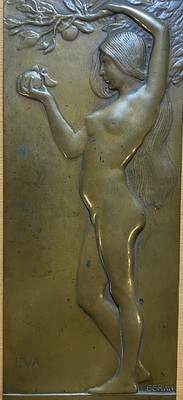 "Adam - Eva" is a 1987 medal by
Kauko Räsänen (1926-2015), arguably the most famous Finnish medalist, famous for his pioneering
multi-part medals and being the second artist not associated with the U.S. to win the Saltus Medal
Award in 1986. 60 mm, ca 170 g, bronze, in an edition of 50 struck by Sporrong Oy, a nominally Swedish
private mint very active also in Finland. This was a medal financed by the artist, i.e., not commissioned
by a client, or a "vapaa mitali" to use the Finnish term. P 134 or HK 132 to use the standard catalogs in
the Finnish market.
"Adam - Eva" is a 1987 medal by
Kauko Räsänen (1926-2015), arguably the most famous Finnish medalist, famous for his pioneering
multi-part medals and being the second artist not associated with the U.S. to win the Saltus Medal
Award in 1986. 60 mm, ca 170 g, bronze, in an edition of 50 struck by Sporrong Oy, a nominally Swedish
private mint very active also in Finland. This was a medal financed by the artist, i.e., not commissioned
by a client, or a "vapaa mitali" to use the Finnish term. P 134 or HK 132 to use the standard catalogs in
the Finnish market.
"I brought it to dinner largely as a contrast, or foil even, or vice versa (sometimes I don't think too deeply about what I grab as an interesting pairing on my way out the door) to an earlier plaque of Eva I acquired much more recently from Hungary. My interest in items from Hungary is more recent, and I acquired this plaque only in September, so I have less to pass along about it. Sometimes the research lags the acquisition of pretty things--many of you probably understand how this goes. It's an undated plaque by Berán Lajos (1882-1943). A one-sided, cast plaque of 185 by 79 mm in bronze.
Right: Bronze Eve
Plaque (Magyar emlekveretek plakettek)
by the Hungarian artist, Beran Lajos (1882 – 1943)
The rest of the story for Terracotta – Item #2: This four and a half inch (11 centimeters) diameter
terracotta, high relief roundel of Benjamin Franklin with legend: B. FRANKLIN – AMERICAIN
and 1777
date was the work of Giovanni Baptista Nini (1717 – 1786), who was an Italian sculptor working in Paris.
This image of Franklin in rugged frontiersman fur cap was used on medallions and snuff boxes popular in
France during the American Revolution. This simple image appealed to the French people which served
to embody the rugged American spirit of Franklin as a ‘natural man' who was only being practical when
he stepped off the boat from America wearing a fur cap to keep his bald head warm. Ben soon sent for
more fur caps to wear throughout his stay in Paris which set him apart from the overly fancy French
styles of couturiers to the Court of Versailles.
The rest of the story for Silver Medal – Item #3: Jon Radel writes that he didn't bring it, yet he remarks that the Swedish government was a great proponent of horse breeding, specifically to ensure a supply of suitable horses for cavalry use, and as such sponsored this as a prize medal. The medal pictured is by Johan Adolf Lindberg (1839-1916), or more commonly Adolf Lindberg, who has signed this particular medal as "A. Lindberg." Lindberg ran his own studio in Sweden starting in 1864, though it was a number of years before he started producing medals. In late 1897 he was appointed to engraver at the royal mint, after the death of Lea Ahlborn, and as such engraved all official medals.
See [J Adolf Lindberg, https://sok.riksarkivet.se/sbl/artikel/10414, Swedish biographical lexicon (art by Ulla Ehrensvärd), retrieved 2022-10-20] for a biography. The medal itself, and the very similar earlier medals by Lea Ahlborn, not to mention later medals with the bust of Gustav V, are relatively common. I found examples of several varieties for sale on eBay, though they largely aren't nearly as nicely toned as the example we saw at dinner.
The rest of the story for Bronze Plaque – Item #4: This large (14.5 x 18.8 cm) bronze plaque of Henry Wadsworth Longfellow, dated 1911, was made for the Grolier Club by John Flanagan who would go on to create the Washington Quarter design used from 1932 to 1998. The Grolier Club was founded in 1884 as a society of bibliophiles, antiquarians, and graphic artists in America. The Grolier Club promotes the study, collecting, and appreciation of fine books and works on paper.
The rest of the story for Bronze Medal – Item #5: This is an 1893 bronze, Chicago World's Fair medal for
The Ferris Wheel
(Highest point 264 feet). George Washington Gale Ferris Jr., a 33-year-old engineer
from Pittsburgh, came up with the idea for his famous wheel after Daniel Burnham, the eminent
architect charged with turning a boggy square mile of Chicago into a world-dazzling showpiece,
assembled an all-star team of designers and gave them one directive: Make no little plans.
But Ferris had not only been challenged to think big; the huge attendance expected at the fair inspired him to bet big. He spent $25,000 of his own money on safety studies, hired more engineers, and recruited investors. On December 16, 1892, his wheel was chosen to answer Eiffel's tower at the 1889 Paris Exposition. It measured 250 feet in diameter, and carried 36 cars, each capable of holding 60 people.
More than 100,000 parts went into Ferris' wheel, notably an 89,320-pound axle that had to be hoisted
onto two towers 140 feet in the air. Launched on June 21, 1893, it was a glorious success. Over the next
19 weeks, more than 1.4 million people paid 50 cents for a 20-minute ride and access to an aerial
panorama few had ever beheld. It is an indescribable sensation,
wrote a reporter named Robert
Graves, that of revolving through such a vast orbit in a bird cage.
But when the fair gates closed, Ferris became immersed in a tangle of wheel-related lawsuits about debts he owed suppliers and that the fair owed him. In 1896, bankrupt and suffering from typhoid fever, he died at age 37. A wrecking company bought the wheel and sold it to the 1904 Louisiana Purchase Exposition in St. Louis. Two years later, it was dynamited into scrap.
Tom submitted a sixth Bonus Item that slipped thru the cracks and didn't make it into the last issue. Here it is. -Editor
Steve Bishop writes:
"It wouldn't be a Nummis Nova dinner without at least one toned Morgan dollar. This is a beautiful 1881-San Francisco, a date known for its superb quality, with a nice crescent of rainbow toning produced by the overlap of another coin as it sat in a sulfur-impregnated mint bag.
"Ag2S is silver sulfide, the layer formed on the surface of metal. O2 is oxygen, and H2S hydrogen-sulfide which is present in the atmosphere. While black in nature, silver-sulfide forms in layers of various thicknesses which creates colors seen through human eyes, through a process called Thin Film Interference Effect (TFIE). A perfect example of what this means is that we see rainbows in soap bubbles based on the angle viewed. TFIE ranges in scale from light-yellow through green. To avoid confusion, this is the scale used for silver-sulfide thickness and not the wavelength scale for human eyesight, where red is at the end. Thereby, green is the final stage before a coin looks black and ruined. Next in the necessary brew for toning are gases in the air. Specifically, sulfur, combined with moisture accelerates the process. Trace amounts of sulfur may occur from cigarette smoke or appliances running on natural gas. In conjunction with the atmosphere, contaminants contact the surface of the coin from materials contain hydrogen-sulfide such as paper, cardboard, tissue-paper, manila envelopes, canvas, etc. Add heat and humidity (2H2O) for rainbows to appear."
To read the earlier E-Sylum article, see:
TOM KAYS NUMISMATIC DIARY: OCTOBER 23, 2022
(https://www.coinbooks.org/v25/esylum_v25n43a26.html)
THE BOOK BAZARRE
Bowers Series.The info-packed reference addresses both the investor and the collector of this popular bullion series. 384 pages. Available December 2022. Order your copy online at Whitman.com , or call 1-800-546-2995.
WAYNE'S NUMISMATIC DIARY: OCTOBER 30, 2022
On Thursday October 27 I had a whirlwind afternoon visit to the Whitman Baltimore Coin Expo. The place was busy as usual, hosting not just the normal show but the Colonial Coin Collectors Club convention as well. Here are the two programs.
I quickly ran into Journal of Early American Numismatics Editor Chris McDowell and spoke for a couple of minutes. Shortly afterwards I bumped into Lianna Spurrier and her mom Sharon. We spoke about the upcoming NNP Symposium and they handed me one of the flyers they were passing out to advertise the event Lianna so deftly manages for the Newman Numismatic Portal. Don't forget to register!
I stopped next at the Colonial Coin Collectors Club (C4) area and said hello to Ray Williams. After a while I met Kyle Knapp in the lobby and we walked down the street for lunch at the Pratt Street Ale House. Kyle is a PCGS grader from California who loves numismatic books and runs the Auditorum Books website (https://auditoriumbooks.com/). He'll soon be the newest sponsor for the NBS website and The E-Sylum.
Back at the convention center I saw Jim Halperin of Heritage walking past for the second time, but I didn't get a chance to talk with him. Vicken Yegparian of Stack's Bowers said hello, and Jim Glickman introduced himself - he'd been at my Nummis Nova group's dinner last week (and I'd missed it because I was out of town). Mark Vitunic also stopped me in the aisle.
I hooked up next with another new friend, Greg Bennick. Greg had done a great interview with error dealer Fred Weinberg that we republished here in The E-Sylum. He'd offered to do more interviews and publish them on the Newman Portal as well as The E-Sylum. He was at the show with his father Dave who'd been collecting since 1948. We walked around the show and I introduced Greg to some folks for future interviews.
 Later I visited the American Numismatic Society table where I found Ray Williams again, talking with Mary Lanin and Austin Andrews. Austin showed me the manuscript for Chris McDowell's new book on Betts medals. It looks great and will soon be published - stay tuned for the formal announcement.
Later I visited the American Numismatic Society table where I found Ray Williams again, talking with Mary Lanin and Austin Andrews. Austin showed me the manuscript for Chris McDowell's new book on Betts medals. It looks great and will soon be published - stay tuned for the formal announcement.
Next I visited numismatic literature dealer Charlie Davis. He had a great three-booth setup. Here are some photos.
Check out those massive numismatic paperweights! From the case shown below I picked out and purchased a nice copy of Harvey Eastman's 1859 Treatise on Counterfeit, Altered and Spurious Bank Notes. Somehow this one had eluded me and I was happy to add it to my library.
The afternoon was a blur. In the course of the day I'd spoken with John Feigenbaum of CDN Publishing, Jeff Garrett and other E-Sylum supporters including Tom Caldwell of Northeast Numismatics and David Kahn. I also spoke with Erik Goldstein and John Kraljevich. Erik remarked that via email I'd alternately told him I would be at the show, then I wouldn't be, and then I would. I said, "I was right two-thirds of the time! I'm going to tell my wife!" I also sold John a small group of tokens and medals I'd accumulated over the years and didn't want anymore. Thanks!
On my way out of the bourse floor I ran into Brian Kendrella of Stack's Bowers and we spoke for a bit about our families. It was a busy day and I hated to leave without seeing more of my friends, but I had to get back to Virginia for a boring overdue oil change. Life can get in the way of numismatics sometimes. But it was a great day and I'm really glad I had a chance to spend some time at the show.
C4 HONORARY LIFE MEMBER CHRISTINE KARSTEDT
Speaking of the Colonial Coin Collectors Club (C4), here's a press release they issued after the show. -Editor
Christine Karstedt With Honorary Life Membership
At the annual C4 Board of Directors meeting held in Baltimore, Maryland, last week, the C4 Board of Directors unanimously agreed to recognize Christine Karstedt's contributions in the area of colonial numismatics by designating her an Honorary Life Member of the Club. Christine has been a regular dues-paying member of C4 for many years. This is the highest honor that can be bestowed by the Club and is rarely awarded. Christine is only the sixth person since 1993 and the first woman to be recognized in this way. She joins past honorees Q. David Bowers, Eric Newman, Kenneth Bressett, Phil Mossman, and Gary Trudgen.
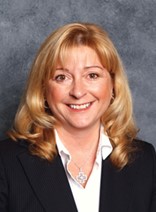 C4 President Christopher McDowell said of Christine that
C4 President Christopher McDowell said of Christine that she is
a leading figure in numismatics and a great friend to our Club.
Mr. McDowell also stated that Christine is the most caring person
I know in coin collecting. She goes well beyond what is expected
of her in handling the estates of our past members. We are
deeply impressed by how she and Stacks honor and care for the
memory of our friends.
Board member Mike Wierzba adds that
she goes out of her way to help our Club succeed, and this
award will permit our members and others to know just how much
our relationship with her has benefitted us.
Finally, C4 Regional
Vice-President Stan Stephens said of this recognition that it
warms my heart to see Christine recognized in this way. I am grateful for the way she
and Stack's recognized our friend Syd Martin during our most recent convention.
Christine Karstedt is Executive Vice President of Stack's Bowers Galleries and has been a fixture at coin conventions around the United States and auctions for over 30 years. She is well known at the podium as a licensed auctioneer and has personally attended nearly every sale hosted by Stack's Bowers Galleries and its preceding firms. Christine has guided the sale of some of the largest and most valuable collections to cross the auction block, including many formerly belonging to members of C4.
Founded in 1993, the Colonial Coin Collectors Club is a non-profit organization whose core mission is to educate the public about colonial numismatics. This is accomplished through its award-winning newsletter and books. C4 also puts on an annual convention that hosts educational speakers and events. For more information on C4 and to learn how to join, please visit the Club's website at: https://colonialcoins.org/
DEBASED SPANISH SILVER: THE "STAR OF LIMA"
A Stack's Bowers blog article by Gabriel Solares discusses the 17th century debasement of Spanish silver coinage. -Editor
By the middle of the 16th century, Spanish dreams of finding the mythical city of El Dorado
were beginning to fade. The colonizers soon found a suitable alternative with Cerro Rico. Located deep within the Andes range, the unassuming peak, dubbed Cerro Rico (Rich Mountain
), provided the Spanish with unimaginable quantities of silver, all extracted by indigenous slaves. While this silver was initially transported to Lima for coinage, the long and perilous route to the Viceregal capital proved untenable. Thus, the town of Potosi, placed at the very base of Cerro Rico, was born. By the time Philip III ascended to the Spanish throne in 1598, the Potosi mint's vast output was almost single-handedly supplying the global economy with silver and making Spain's empire fabulously rich in the process. So unparalleled was its production that the Crown shut down the Lima mint indefinitely as it could not keep up.
It did not take long for this trajectory to shatter. In the early 17th century, traders began to cast doubts on the fineness and weight of Potosi coinage. Once foreign governments stopped accepting silver Reales from Potosi at their nominal value, Spain was forced into action. In 1648, Philip IV sent the inquisitor Francisco de Nestares Marin to investigate. Within a year, Nestares Marin uncovered a vast web of corruption, with parties at all levels guilty of producing deliberately debased coinage and pocketing the difference. Over 100 implicated individuals received punishment, and several of the guiltiest were executed by strangulation, including the assayers Jeronimo Velasquez and Juan Rodriguez de la Rocha. Faulty coins were melted down and a new assayer took office, but these reforms were insufficient to restore global faith in Spanish silver. Furthermore, hoarding of the new specie created a disastrous shortage of circulating coinage. This crisis escalated to the point where the Viceroy of Peru, without the permission of the Crown, unilaterally reopened the Lima mint and produced the unique Star of Lima
issues before the Spanish authorities shut down this illegal action just a year later.
Things finally settled down in 1652 when, after a series of short-lived prototype issues, a new coin design was settled upon that included the date and assayer's name in at least three places. This bold new design ensured that the origins of faulty coins could be traced even in extremely crude examples. Sacrificing beauty for security, this type was in continuous production at Potosi until Cob coinage finally ceased more than a century later.
Our November 2022 Collectors Choice Online auction will feature Pat Johnson's vast collection of Latin American issues, including a nearly complete date run of Cobs from Potosi and Lima. Among them are rare issues of the later-executed assayers Velasquez and de la Rocha, seldom-seen transitional and countermarked types from 1652, and a coveted one-year Star of Lima
issue. Each stage of this pivotal period, from the initial fraud and the transitional types to the unauthorized Lima issues and final redesign, is offered through spectacular examples from the Pat Johnson Collection. Each coin in this extraordinary offering tells the story of Spain's insatiable greed and the gradual development of the Latin American identity that it inadvertently initiated.
To read the complete article, see:
A SCANDAL THAT SHOOK THE WORLD
(https://stacksbowers.com/a-scandal-that-shook-the-world/)
An article by Daniel Frank Sedwick on the sedwickcoins.com site describes the history of the Star of Lima
coinage. Here's an excerpt - see the complete article online.
-Editor
This is a case of it's easier to ask forgiveness than it is to get permission.
The city of Lima, Peru, was short of silver coinage and needed to remedy the situation before the king could be asked. For 67 years the Lima mint remained closed while coins were struck at a furious rate in Potosí, the source of the silver. To avoid heavy taxation, wealthy mine owners were shipping their coins and even whole ingots back to Spain, sometimes even using contraband eastward routes to Buenos Aires. The situation was no doubt exacerbated by the Potosí debasement scandal and subsequent recall of coinage in 1649-1652. When the Lima town council suggested re-opening the Lima mint in 1658, the Viceroy, Count Alba de Liste, considered it within his authority to allow it, without Philip IV's permission up front. Forgiveness eventually came, but permission did not.
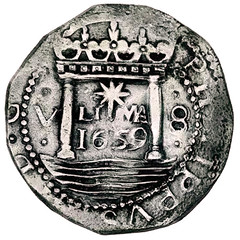 Documents show that the Lima mint began striking this unauthorized coinage in January 1659 and ceased in April 1660. One of the great mysteries of Spanish colonial numismatics is why the mintage continued for so long when the king clearly did not approve. One theory is that the first samples for the king were lost on a shipwreck, for the remains of the San Miguel el
Arcángel, sunk in 1659 off Jupiter, Florida, have yielded many round and well-struck presentation examples. In fact this wreck
has become the primary source for
Documents show that the Lima mint began striking this unauthorized coinage in January 1659 and ceased in April 1660. One of the great mysteries of Spanish colonial numismatics is why the mintage continued for so long when the king clearly did not approve. One theory is that the first samples for the king were lost on a shipwreck, for the remains of the San Miguel el
Arcángel, sunk in 1659 off Jupiter, Florida, have yielded many round and well-struck presentation examples. In fact this wreck
has become the primary source for Star of Lima
coins, but only for the year 1659. As we shall see, the coins that are not from
the wreck, presumably struck later, had slightly different designs.
The design is where the moniker for this series of unauthorized coinage becomes obvious, for the central element on the obverse of each coin is a large star, which symbolized Lima from its founding as Ciudad de los Reyes (City of the Kings). In much smaller form the star was used on Lima's previous coinage under assayer Diego de la Torre, from 1577 to 1588 (with one more year of recorded production in 1592), placed interchangeably with the P mintmark, the oD assayer-mark and the denomination around the central obverse element (shield or monogram). The new version of Lima's star used in 1659 and 1660 was large and prominent.
To read the complete article, see:
An Introduction to the Star of Lima
Coinage of 1659-1660
(https://www.sedwickcoins.com/articles/Star_of_lima.pdf)
FIRST AMERICAN COIN WITH THE WORD "CENT"
Another Stack's Bowers blog article, this one by Chris Bulfinch, discusses the first American coin with the word "cent" in its design. -Editor
The casual substitution of penny
for cent
by American consumers is so ubiquitous that there's no sense in trying to correct anyone who calls our national one-cent coins by the name of their British predecessors. Cents are pennies now. With the terms so thoroughly conflated, it's hard to imagine a time when the distinction mattered, but in the 1780s it was meaningful. Today we're going to take a very brief look at the first use of the cent
denomination on American coinage, the Massachusetts coppers of 1787-1788.
After the Revolution, the newly independent states grappled with the financial fallout from the conflict, producing coinage as a circulating medium of exchange and an expression of sovereignty. The second Massachusetts mint was unusual among post-Revolution state minting efforts, in that it was a public enterprise, authorized by the state legislature on October 16, 1786. In its short life it struck copper coins denominated half cent and cent in accordance with a 1785 Federal resolution decimalizing the Spanish milled dollar.
The half cents and cents share a design, with a standing Native American holding a bow in one hand and an arrow in the other on the obverse, a motif derived from the State Seal. A heraldic eagle with wings spread, clutching an olive branch and a cluster of arrows, appears above the date on the reverse, encircled by MASSACHUSETTS.
The denomination appears in incuse lettering at the top of the shield on the eagle's breast; one variety of the cent is known with the denomination rendered with raised letters.
These coins are, according to many numismatist historians, the first coins struck in the United States to bear the denomination cent.
Two notable engravers, Joseph Callender and Jacob Perkins, worked on Massachusetts cents and half cents. Callender was based on State Street, the same street where Stack's Bowers Galleries just opened a new gallery.
The coins were not, in the late 1780s, economical to produce. When production stopped in January 1789, their face value was eclipsed by production costs. An audit found that the copper coins' cumulative face value was less than half of the expense to produce them. Their cost notwithstanding, the coins spent decades in circulation and were fairly popular.
Counterfeit Massachusetts cents and half cents were produced, of lighter weights than the authorized coinage, likely at Machin's Mills. Interestingly, examples of counterfeit 1787 Massachusetts cents were used as planchets for 1788 Connecticut coppers, as they were comparable in weight to the official Connecticut issues.
The Massachusetts legislature officially closed the mint on Nov. 17, 1788, but operations continued until the facility ran out of copper and it fully shuttered on January 23, 1789. The Constitution went into effect later that year, ending any further state coinage and closing an important chapter in early American numismatic history.
We're offering an example of each Massachusetts denomination in our Winter 2022 Showcase Auction in lot 3117 and lot 3118.
Here's the 1787 Massachusetts Cent, with a great provenance: Ex Wayte Raymond's sale of the Ellsworth Collection, April 1923, lot number not recorded; Hillyer C. Ryder; F.C.C. Boyd; John J. Ford, Jr.; our (Stack's) sale of the John J. Ford, Jr. Collection, Part V, October 2004, lot 95. Stack's lot tag, Ryder ticket, Boyd envelope and additional collector envelope with attribution and provenance notes included. -Editor
To read the complete article, see:
DID YOU KNOW THAT THE MASSACHUSETTS COPPERS OF 1787-1788 WERE THE FIRST AMERICAN COINS TO BEAR THE DENOMINATION CENT?
(https://stacksbowers.com/did-you-know-that-the-massachusetts-coppers-of-1787-1788-were-the-first-american-coins-to-bear-the-denomination-cent/)
To read the complete lot descriptions, see:
3117 1787 Massachusetts Half Cent. Ryder 3-A, W-5920. Rarity-4. AU-55 (PCGS).
(https://auctions.stacksbowers.com/lots/view/3-ZA61U/1787-massachusetts-half-cent-ryder-3-a-w-5920-rarity-4-au-55-pcgs)
3118 1787 Massachusetts Cent. Ryder 3-G, W-6090. Rarity-2. Arrows in Left Talon. AU-55 (PCGS).
(https://auctions.stacksbowers.com/lots/view/3-ZA62O/1787-massachusetts-cent-ryder-3-g-w-6090-rarity-2-arrows-in-left-talon-au-55-pcgs)
With perfect timing for the Halloween holiday, here's how serious numismatists celebrate. Found in the Fall 2022 issue of The C4 Newsletter from the Colonial Coin Collectors Club. Thanks to Editor Will Nipper for providing the photo and caption for publication here. Happy Halloween! -Editor
Scene from Halloween 2021: Ron Swinnich of Westford, MA after carving a jack-o-lantern of a 1787 Massachusetts cent.
If based on a real coin, Mass. copper expert Mike Packard would assign this Obverse K,
a unique three-arrows variety!
For more information on the Colonial Coin Collectors Club (C4), see:
https://colonialcoins.org/
THE UNIQUE 1670-A DOUBLE DE L'AMERIQUE
And here's the first coin ever to name the North American continent. Although I missed mentioning this important coin before the sale, I wanted to include something here. It sold for $504,000. Congratulations to the new owner. -Editor
1670-A French Colonies Double de l'Amerique. Paris Mint. Martin, chapter 5. Lecompte-185, W-11600, Breen-257. VF-35 (PCGS).
62.3 grains. The crown jewel of the Syd Martin Collection of French colonial coins and one of the most significant rarities in the entire realm of early American numismatics.
This is the most significant French colonial coin in existence. Struck as part of the first coinage intended for the French New World, it is both the first and the rarest. This is the only specimen extant. The reverse reads DOVBLE / DE LA / MERIQUE / FRANCOISE or "double of French America." The engraving error, which substituted an incorrect De La Merique instead of the correct De L'Amerique, should not overshadow what this coin states: it was produced for French America. It is the first coin ever struck to name this landmass as part of its designs.
This piece has been offered publicly only once, in the 1996 Norweb Canadian sale. Before and since, dating to the time this coin was in the legendary cabinet of Count Phillip Ferrari de la Renotiere (1850-1917), collectors have only had a chance to acquire this coin by private treaty. Since Virgil Brand acquired Ferrari's French coin cabinet intact in 1924, just four collectors have owned it: Virgil Brand, Emery May Norweb, Anthony Terranova, and Syd Martin. But 50 years before the coin reached American shores for the first time, American collectors already knew about this coin and coveted it. First mentioned in the American Journal of Numismatics in 1870, Crosby illustrated this coin in the 1875 Early Coins of America by virtue of a copy provided by "M. Jules Marcou, of Cambridge."
The image on Crosby's Plate III doesn't allow us to definitively identify it as a cast or an electrotype; there appear to be one of each, made around this time, in the collection of the Bibliotheque Nationale, and Marcou's was probably from the same batch as one of them. Marcou, a French-born geologist who worked alongside Louis Agassiz, is perhaps best known to American numismatists as the man whose original Diplomatic Medal cliches were provided to the U.S. Mint in 1876 to be copied by engraver William Barber. At the time Crosby published this piece for the first time, little was known of the coin's origin or of its intended distribution.
As recounted by Jerome Jambu in his definitive article on the 1670 coinage of the French West India Company (Journal of Early American Numismatics, 2021), the concept of a double (or two) denier piece struck for French possessions in the New World dates to 1665, when a plan was hatched to strike 2.4 million of them, along with silver 15 and 5 sols coins. The adopted 1670 plan echoed that from 1665, with plans to source the raw copper for the doubles from melting older double tournois coins that were recovered at the French mint in Nantes. The coppers were to be struck in Paris and shipped, alongside their silver brethren, to islands of the French West Indies. In the weeks before the coins were to be struck on a massive scale, a new regulation was passed down from the King's Council of Commerce that would end the coinage of doubles before it began. On June 23, 1670, the French government authorized the doubles to be replaced by old double tournois and billon sols in the Caribbean-bound shipment, a revelation that, as Jambu wrote, "was the first official authorization of the export of coins from the French kingdom to the Antilles."
This document was written on June 23, 1670. The mintage of silver 5 sols and 15 sols began at the Paris mint on July 7, just two weeks later. Sometime in that roughly two-week period, some small number of "doubles for French America" were struck, leaving a total surviving population of one. The dies were included in a 1672 estate inventory of equipment belonging to Jean Warin, the Paris mint engraver. Whether a small mintage was struck with intentions to circulate them - and some were released - or if this coinage belongs more to the realm of patterns (or essais), we may never know: the documents are silent. The only relevant document we have is this coin, which clearly saw some circulation. There are essais extant from the Paris Mint in this era, often high grade, nicely preserved in a cabinet from the time of their mintage. This example is something different: worn, used as money, and, it would appear, struck for circulation.
As the first and rarest of its kind, this coin's fascination among collectors far surpasses the world of French colonial coinage. This is a collection centerpiece, just as it was in the Norweb Collection, and just as it was for Syd Martin.
To read the complete lot description, see:
1670-A French Colonies Double de l'Amerique. Paris Mint. Martin, chapter 5. Lecompte-185, W-11600, Breen-257. VF-35 (PCGS).
(https://auctions.stacksbowers.com/lots/view/3-Z9T2R/1670-a-french-colonies-double-de-lamerique-paris-mint-martin-chapter-5-lecompte-185-w-11600-breen-257-vf-35-pcgs)
ROYAL MINT STRIKES KING CHARLES 50P COINS
David Pickup passed along this BBC story about the Royal Mint's striking of the King Charles 50 pence coins. Thanks. -Editor
Manufacturing has begun of the first coin to enter general circulation carrying the image of King Charles.
The 50p coin has started to be struck at The Royal Mint in Llantrisant, Wales, and will enter tills, wallets and purses in December.
Sculptor Martin Jennings, who created the portrait of the King, said that witnessing the coin being produced was a "quite remarkable experience".
He said it took months of painstaking work to get the image right.
He used pictures of King Charles on his 70th birthday to create a likeness of the monarch, in what is the smallest work he has ever had to produce.
"It has to be an exact portrait but also that says something about the lasting values of the institution he represents," Mr Jennings said.
"In subtle and tiny ways, you can put these things across."
King Charles's portrait is the first coin design undertaken by Mr Jennings, but his public sculptures include poets John Betjeman, in St Pancras Station in London, and Philip Larkin in Hull.
The reverse side of the coin is a copy of the design used on the 1953 Crown struck to commemorate the Queen's coronation.
The 50p coins will be available for general use in December, distributed according to demand by banks, building societies and post offices. Eventually, 9.6 million 50p coins of the latest design will be made. Other denominations will be manufactured, carrying the King's image, in line with demand.
To read the complete article, see:
King Charles 50p coins struck for the first time
(https://www.bbc.com/news/business-63413134)
STAGE MONEY STOLEN IN AUSTRALIA
Don Cleveland passed along this article about the theft of stage money stolen from a film production venue in Alice Springs, Australia. Thanks. -Editor
Northern Territory businesses are being warned to lookout for fake cash that has been stolen from a film production venue in Alice Springs.
Fake bank notes bearing portraits of wildlife expert Steve Irwin and actor Raymond Meagher, who plays Alf in television series Home and Away, were stolen from a property on Wilkinson Street in Alice Springs overnight on Monday, October 24.
The bank notes were being used for film and TV production.
Detective Acting Senior Sergeant Robert Kent has said it is unknown how much of the money was stolen and how many people were involved in the theft.
"At this stage investigators are unsure of how much fake money was stolen but it may include $10, $20, $50 and $100 dollar bills," he said.
Police are warning businesses to beware of anyone trying to use the notes.
Apart from the notes featuring pictures of Steven Irwin and Raymond Meagher in place of where Sir John Monash and Dame Nellie Melba are on real bank notes, the cash also says 'Straylia' in place of the word 'Australia'.
The pictures of the Australian Masked Owl and Native wattle on real bank notes have also been replaced by a mining haul truck on the fake notes, and the Shrine of Remembrance has been replaced with a picture of singer John Farnham.
To read the complete article, see:
Fake cash picturing Steve Irwin and Ray Meagher stolen in Alice Springs
(https://www.9news.com.au/national/fake-cash-picturing-steve-irwin-and-ray-meagher-stolen-in-alice-springs/c2556e89-a978-43ab-9d03-7955c1dc21aa)
STAGECOACH ROBBER BLACK BART THE POET
In today's "This Week in Literary History" email from the Literary Hub is a profile of stagecoach robber "Black Bart the Poet". -Editor
Black Bart the poet
robs his last stagecoach.
On November 3, 1883, the gentleman bandit known as Black Bart the poet—because of the poems he left behind at the scenes of two of his crimes—robbed his last stagecoach before being apprehended by the authorities. By then, Black Bart had been robbing stagecoaches in California's gold country for eight years—unbeknownst to the many members of San Francisco high society who knew him as Charles Bolton, a courteous middle-aged mine owner who sported diamond accessories along with his cane, derby hat, and gold watch. (According to Daniel R. Seligman writing in True West Magazine, Bolton got the name Black Bart
from the villain in William H. Rhodes's novel The Case of Summerfield, which had been serialized in the Sacramento Daily Union in 1871.)
Black Bart was courteous too—he avoided violence (some say his shotgun was never even loaded) and declined to steal from the passengers of the stagecoaches he robbed. All he would take was the Wells Fargo express box and the mail. During his first robbery, on July 26, 1875, near the top of Funk Hill at the head of Yaqui Gulch,
writes Seligman, he politely requested the Wells Fargo box. When a thoroughly frightened woman passenger threw her purse out of the window, he gallantly returned it with the words,
I don't want your money—only the express box and mail.
And also courteously . . . he left poems.
After his fourth robbery, he left behind this fine piece of verse:
For honor and for riches,
But on my corns too long you've tred
You fine-haired sons of bitches.
–Black Bart, the P o 8.
After his fifth robbery, he got a little more ambitious:
To wait the coming morrow.
Perhaps success, perhaps defeat,
And everlasting sorrow.
Let come what will, I'll try it on,
My condition can't be worse;
And if there's money in that box
Tis munny in my purse.
–Black Bart, the P o 8.
It wasn't until Black Bart's 29th holdup that he was finally caught, after he left a handkerchief (seriously!) at the scene. He was apprehended on November 12th, and four days later, he pled guilty and was sentenced to eight years in jail. He was released after only four, for good behavior—as befits a gentleman—and soon after that, he disappeared entirely—as befits a poet.
For more from the Literary Hub, see:
https://www.lithub.com/

